DITA
Making AI Agents Smarter: How to Turn Your Technical Documentation into an AI-Powered Knowledge Assistant
By Sana Remekie, CEO, Conscia.AI
Picture this: Your team has spent months creating comprehensive technical documentation in your content management system. It's well-structured, detailed, and theoretically helpful. But when someone asks ChatGPT or your company's AI assistant a specific question about your product, it either can't find the right information or gives a generic answer that misses the nuances of your particular setup.
Sound familiar? You're not alone. Most technical documentation sits isolated in content management systems, invisible to the AI agents that could make it incredibly useful.
The Content Wrangler is a reader-supported publication. To receive new posts and support my work, consider becoming a free or paid subscriber.
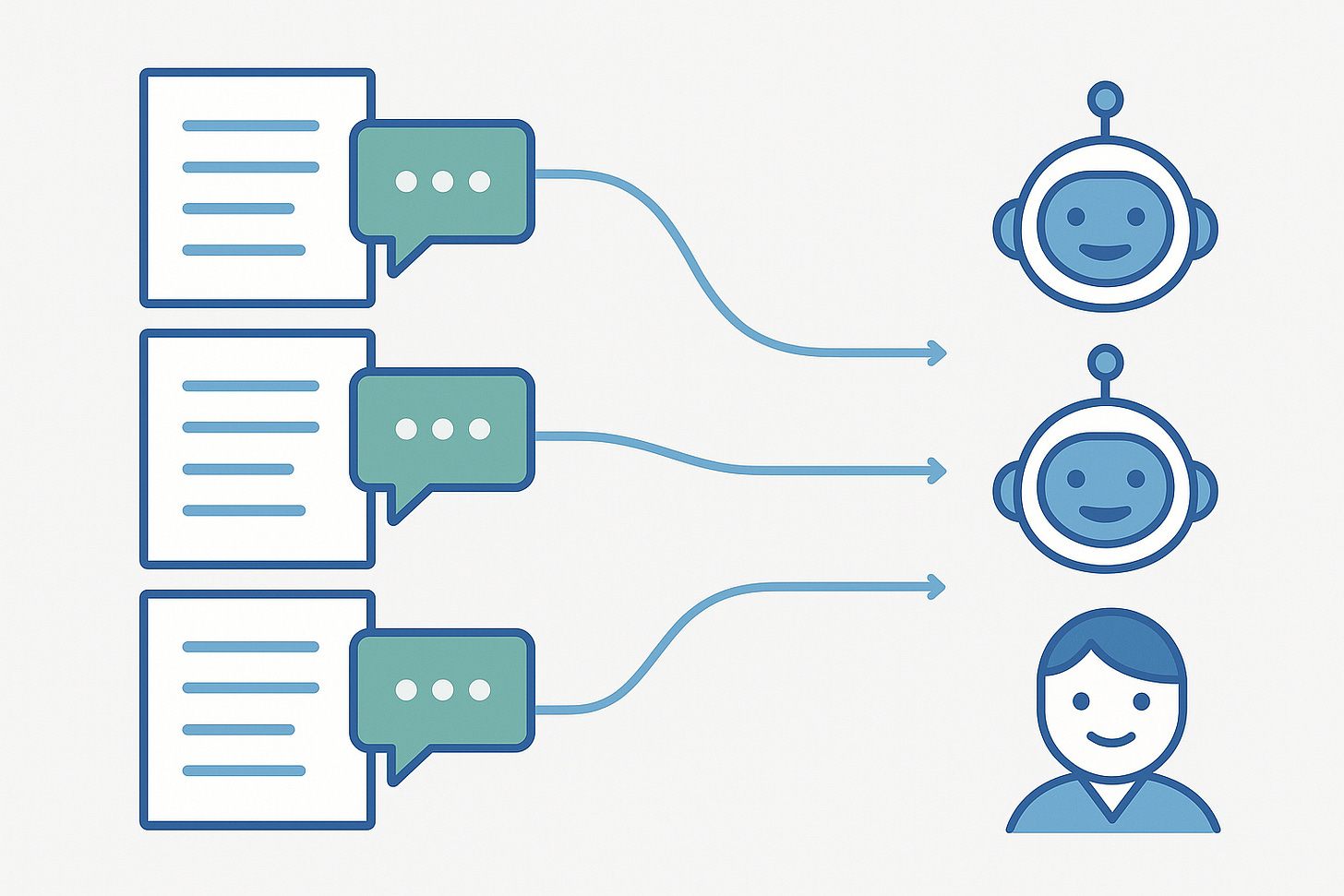
What If Your Docs Could Talk to AI?
Imagine if every piece of your technical documentation could be instantly discovered and understood by AI agents. Not just keyword searching, but truly intelligent retrieval that understands context, relationships between topics, and can provide exactly the right information at exactly the right moment.
That's exactly what this guide will show you how to build—a system that transforms your static documentation into an AI-native knowledge assistant.
The Big Picture: From Static Docs to Smart Answers
Here's what we're building: a pipeline that takes your structured documentation (like DITA content from Heretto CCMS) and makes it discoverable by AI agents through natural language queries. When someone asks "How do I install the CLI?", the system doesn't just return a list of potentially relevant pages—it understands the context, finds related prerequisites and troubleshooting guides, and delivers a comprehensive, structured answer.
Why This Approach Works
The secret sauce is treating your documentation as what it really is: structured knowledge with relationships and meaning. When you author content in formats like DITA XML, you're not just creating documents—you're encoding semantics. The system knows the difference between a task, a concept, and reference material. It understands prerequisites and can follow relationship links between topics.
This structure is what makes AI retrieval so much more powerful than traditional search.
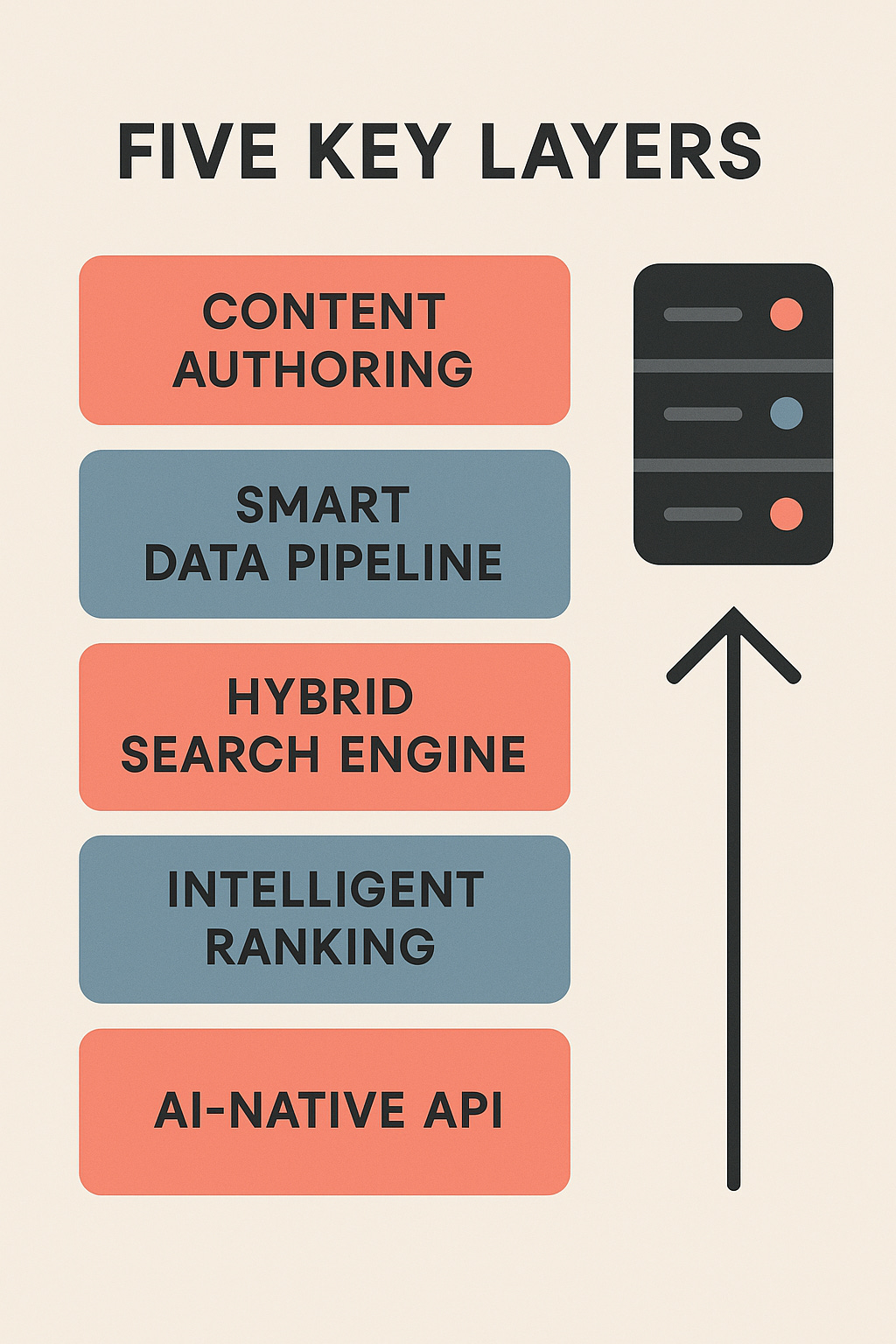
The Architecture: Five Key Layers
Let's break down how this system works without getting too deep into the technical weeds:
1. Content Authoring (Your Writers Keep Writing)
Your content team continues working in their familiar environment—CCMS, creating DITA topics and maps. Nothing changes for them, which is crucial for adoption.
2. Smart Data Pipeline (The Magic Happens Here)
When writers publish new content, the system automatically:
Exports the structured content from your CCMS
Transforms it into a knowledge graph that understands relationships between topics
Creates searchable indexes that support both keyword and semantic search
Sets up real-time synchronization so updates appear almost immediately
3. Hybrid Search Engine (Best of All Worlds)
Instead of relying on just one search method, the system combines:
Keyword search for precise term matching
Vector search for semantic understanding
Graph relationships for contextual connections
This "hybrid RAG" (Retrieval-Augmented Generation) approach means when someone asks about troubleshooting, the system can find not just documents containing those words, but related concepts, prerequisites, and follow-up tasks.
4. Intelligent Ranking (Business Logic Meets AI)
The system doesn't just return results—it ranks them intelligently using:
Search relevance scores
Business rules (like prioritizing task-oriented content)
Relationship density (topics with more connections often contain richer information)
Optional AI re-ranking for the most relevant results
5. AI-Native API (The Interface)
Everything is exposed through a Model Context Protocol (MCP) server that AI agents can easily integrate with. Whether it's ChatGPT, your custom assistant, or a voice bot, they can all ask natural language questions and get structured, actionable answers.
The Implementation Flow: How It All Works
Here's what happens when someone asks your AI assistant a documentation question:
Query Processing: The AI agent sends a natural language query to your documentation system
Hybrid Search: The system simultaneously searches for keyword matches and semantic similarity
Graph Enrichment: For each potential result, the system looks up related topics, prerequisites, and troubleshooting information
Intelligent Scoring: Results are ranked using both relevance and business rules
Structured Response: The AI agent receives enriched, contextual information to craft a comprehensive answer
All of this happens in under 200 milliseconds—fast enough for real-time conversations.
Real-World Benefits You'll See
For Your Users
Instant, accurate answers to technical questions instead of hunting through documentation
Contextual information that includes prerequisites, related topics, and troubleshooting steps
Consistent experience across different AI interfaces (ChatGPT, company chatbots, etc.)
For Your Content Team
No workflow changes—they keep writing in their familiar tools
Automatic synchronization means their updates are immediately available to AI agents
Analytics and insights about which content is most useful and where gaps exist
For Your Technical Organization
Reduced support burden as users can self-serve more effectively
Improved onboarding for new team members who can ask natural language questions
Cross-system integration that connects documentation to products, support tickets, and other business data
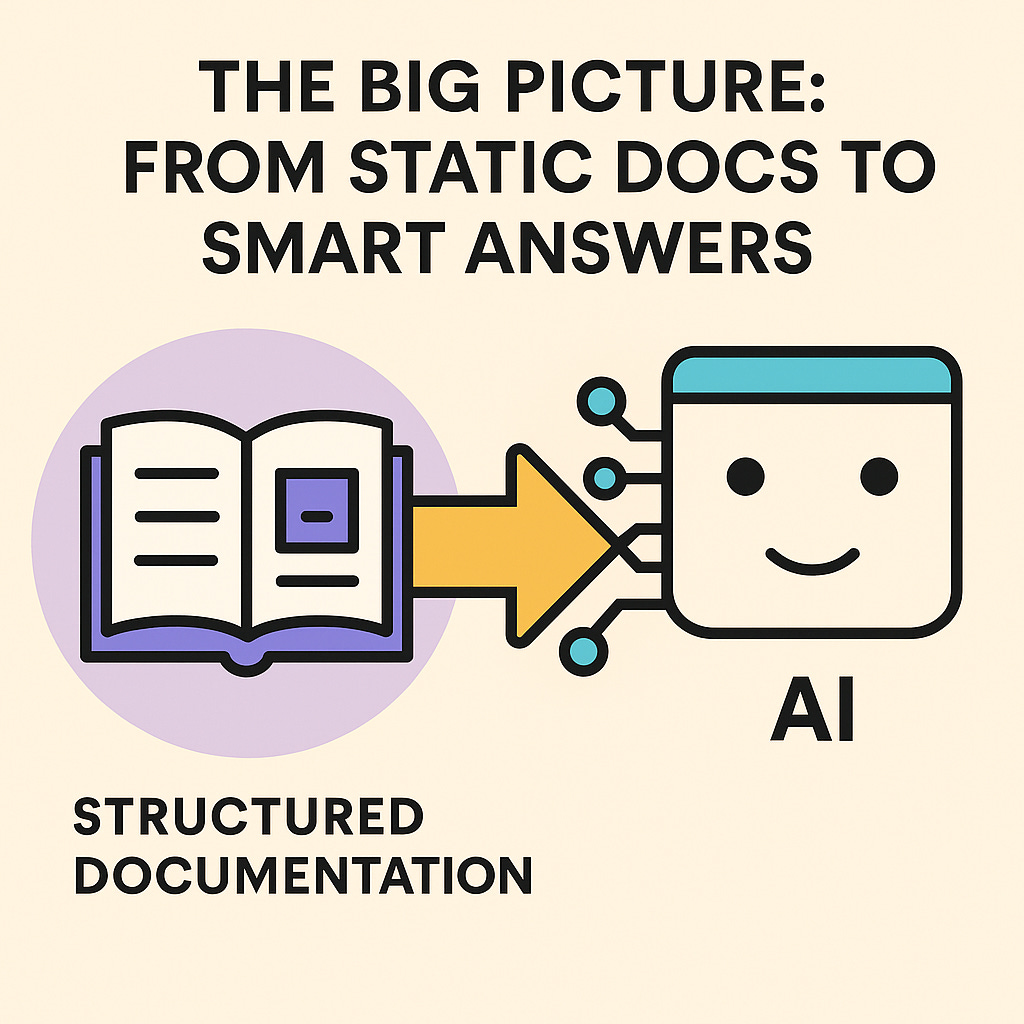
Getting Started: The Building Blocks
To implement this system, you'll need several key components working together:
Content Export: Automated extraction from your current documentation system (like Heretto's Deploy API for regular JSON exports)
Data Processing: Jobs that transform your content into a searchable knowledge graph with proper relationships and metadata
Search Infrastructure: A hybrid search engine (like OpenSearch) that can handle both keyword and vector searches simultaneously
Orchestration Engine: A system that coordinates the search, graph lookup, and ranking processes
Agent API Gateway: An MCP server that exposes your documentation capabilities to AI agents
Key Success Metrics to Track
When you implement this system, here are the metrics that matter:
Discovery Accuracy: AI agents should find relevant documentation with over 90% accuracy
Response Speed: Search responses delivered in under 200ms for good user experience
Synchronization Time: New content should be available to AI agents within 5 minutes of publishing
Query Satisfaction: Users should find complete answers without needing to dig through multiple documents
Common Pitfalls to Avoid
Over-Engineering: Start with basic hybrid search before adding complex AI re-ranking. You can always enhance later.
Ignoring Content Structure: The power of this approach comes from structured content. If your documentation isn't well-structured, fix that first.
Neglecting Performance: AI agents need fast responses. Optimize for speed from day one.
Forgetting the Human Element: Even with great AI integration, your content still needs to be well-written and logically organized.
The Bottom Line
Your technical documentation is a goldmine of structured knowledge that AI agents can unlock—if you build the right bridges. By implementing a system that combines hybrid search, knowledge graphs, and intelligent ranking, you transform static documentation into a powerful AI-native knowledge assistant.
The result? Your users get instant, accurate answers to complex technical questions, your content team sees their work having greater impact, and your organization reduces support burden while improving user experience.
Most importantly, this isn't a replacement for good documentation—it's a multiplier that makes your existing investment in content dramatically more valuable.
Ready to make your documentation AI-native? The pieces are all available, and the benefits are real. The question isn't whether this approach works—it's how quickly you can implement it to start seeing the benefits. 🤠
Sana Remekie is CEO and co-founder of Conscia.ai, a Toronto-based enterprise software-as-a-service company.
The Content Wrangler is a reader-supported publication. To receive new posts and support my work, consider becoming a free or paid subscriber.
When Content Creators Sacrifice Efficiency For The Convenience of Others
This post was inspired by a thoughtful LinkedIn post from content operations expert Rahel Anne Bailie. In it, she identifies five common situations where content professionals are expected to sacrifice their own efficiency to make life easier for others — usually in ways that increase overhead, introduce unnecessary complexity, and lead to long-term content chaos.

I’ve taken each of her five points and written a short reflection about each aimed at technical writers, sharing what it often feels like when these scenarios show up in the real world.
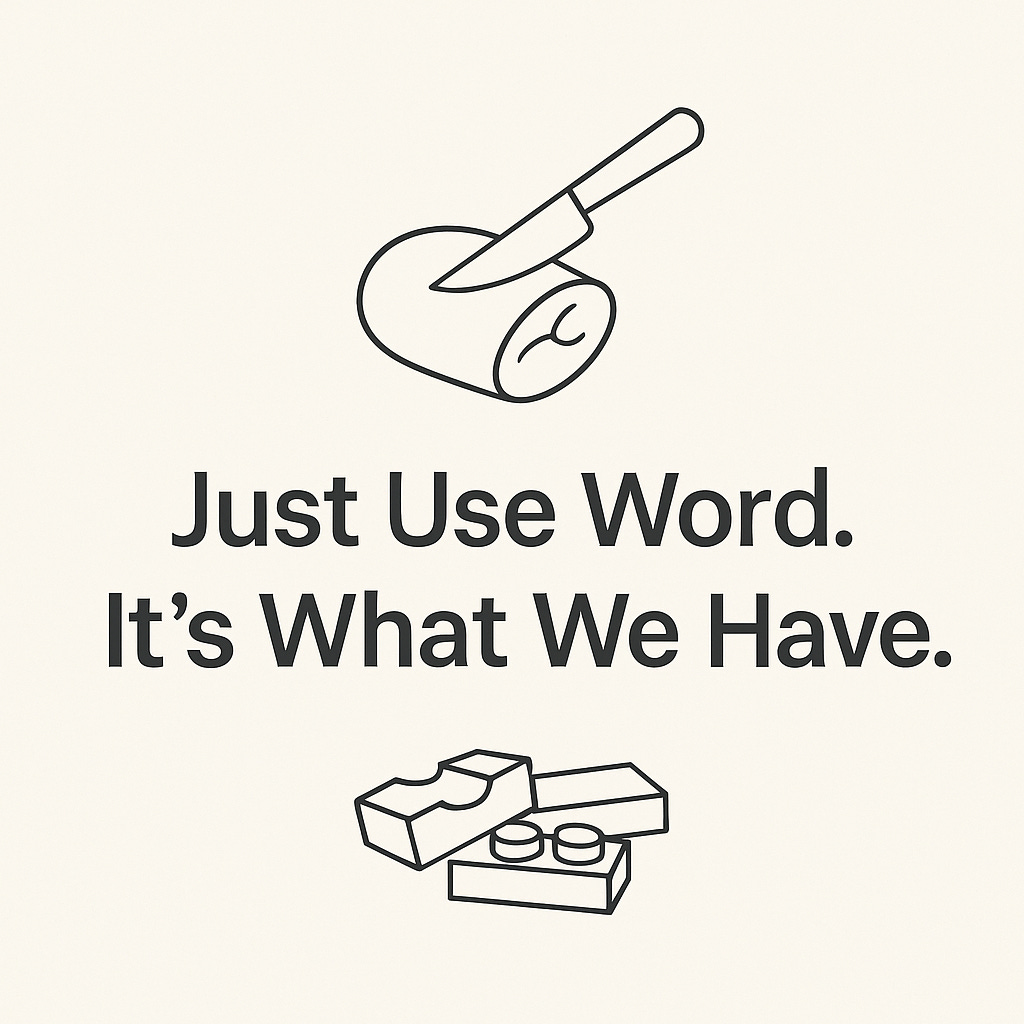
Imagine being handed a butter knife and asked to slice through a frozen ham. That’s what it feels like when you’re expected to write enterprise-grade content in tools meant for grocery lists and birthday invitations.
“But it’s free,” they say, while you scream internally, massaging the carpal tunnel you got from trying to force a table to behave in Microsoft Word.
Sure, you can do it. You can also cut your lawn with nail scissors. But should you?
Let’s stop pretending that “free” tools are actually free. They cost us time, sanity, and clean content. Tools should serve the process, not sabotage it.
How Semantically Rich Global Content Drives Profitability and Scale
If you’ve ever watched hard-won product copy get mangled in translation, you’ll appreciate the recorded webinar “How Semantically Rich Global Content Drives Profitability and Scale.” It’s free, on-demand here.
Who’s talking?
Scott Abel – Content Strategy Evangelist at Heretto and founder of The Content Wrangler. Scott distills decades of structured-content know-how into clear actions technical writers can use today.
Ron Myers – Director of NA SMB Omnichannel Digital Transformation at Lenovo. Ron brings 25 years of leading digital-first content programs that tie directly to revenue.

Who’s footing the bill?
The webinar is sponsored by Acclaro—a global translation and localization partner with offices on four continents. Acclaro combines expert linguists and AI-enabled workflows to help brands ship consistent, market-ready content in 125 + languages.
Why hit play?
See how semantic markup shrinks translation memory costs.
Learn practical steps to make reuse and personalization painless.
Hear real metrics that connect structured content to profit.
Set aside 40 minutes, grab a coffee, and discover how better structure today means faster, cheaper global delivery tomorrow. Your future multilingual readers—and your budget—will thank you. 🤠
The Content Wrangler is a reader-supported publication. To receive new posts and support my work, consider becoming a free or paid subscriber.
Gilbane Advisor 7-30-25 — Neurosymbolic AI, on-device models, chat lies
I Think In Components
My friends call me a digital music collage artist—which is a fancy way of saying I repurpose and rearrange bits of audio into reworked remixes of popular dance tracks. I take stems—those individual pieces of a song like vocals, bass lines, and drum loops—and weave them into something fresh. Something that moves you, maybe even makes you sweat a little (or a lot) on the dance floor.

See also: The Audio Wrangler channel on SoundCloud
 Dragonfly Garden (2023) by Scott Abel — Jewelry on board in acrylic resin
Dragonfly Garden (2023) by Scott Abel — Jewelry on board in acrylic resinThat instinct to break things down and build them back up again doesn’t stop with music. It shows up in my art, too.
I make art using discarded components from old, broken, costume jewelry. Not to fix them. Not to make new jewelry. But to make something else entirely—art born from scraps of jewelry. And, not surprisingly, it’s the same instinct that drives my work in technical documentation.
Why Tech Writers Should Be the Business Case Cheerleaders for Content Projects
Let’s be honest: most content improvement projects begin not with a bang but with a passive-aggressive comment in a Zoom chat.
We see the chaos. We see the ancient templates that haven’t been updated since Windows Vista. The publishing process that requires a prayer, a goat sacrifice, and five rounds of manual PDF tweaking. And we think: this is a disaster.
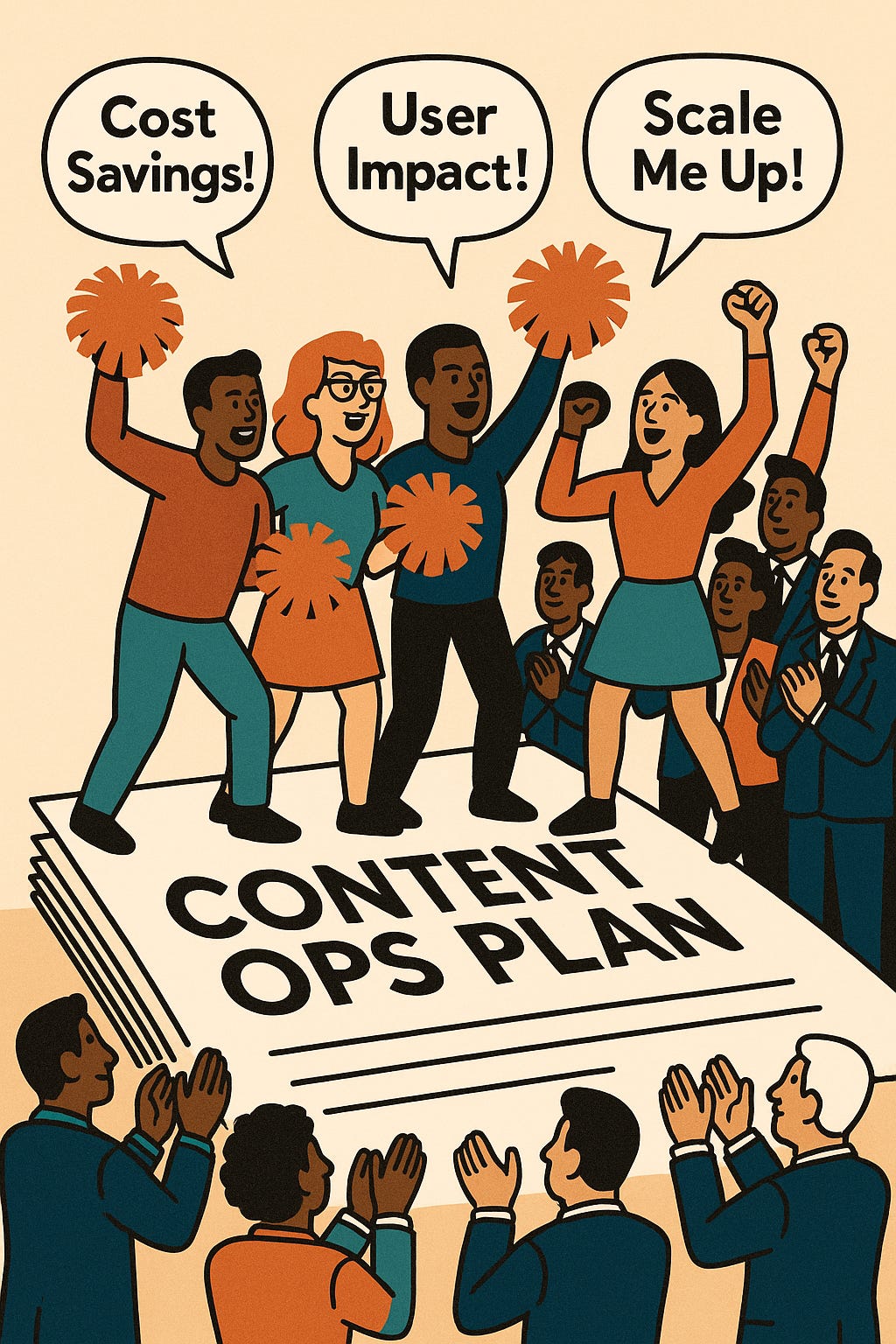 Image: ChatGPT
Image: ChatGPTAnd yet, we smile. We nod. We click “resolve comment” and move on. Because advocating for change? That sounds exhausting. And vaguely like project management.
Here’s the truth we need to face: we’re the best people to make the business case for fixing this mess.
We know the problem. We live it. And we can connect the dots between “this doc is a hot mess” and “this is costing us real money.”
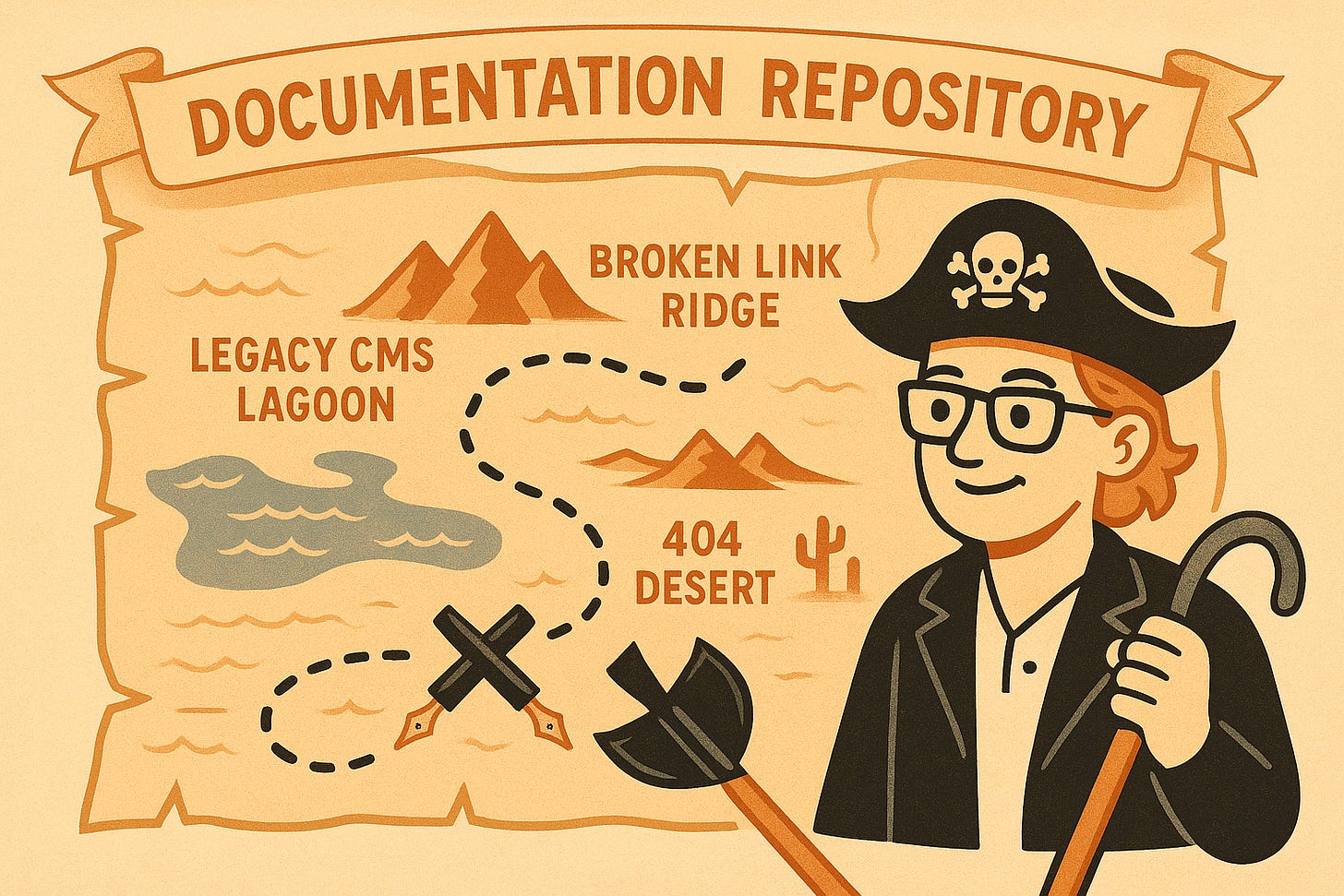 Image: ChatGPT
Image: ChatGPTWe Know Exactly Where the Content Skeletons Are Buried
Let’s not pretend otherwise. We are aware of which content exists in twelve different versions across five systems. We know which reviewers never respond unless bribed with tasty snacks. We know which parts of our publishing process involve someone manually replacing curly quotes—every single time.
And while it’s tempting to keep it to ourselves (because it makes for great group chat gossip), we are in the best position to shine a light on what’s broken. More importantly, we can explain what fixing it could save—in time, money, and human dignity.
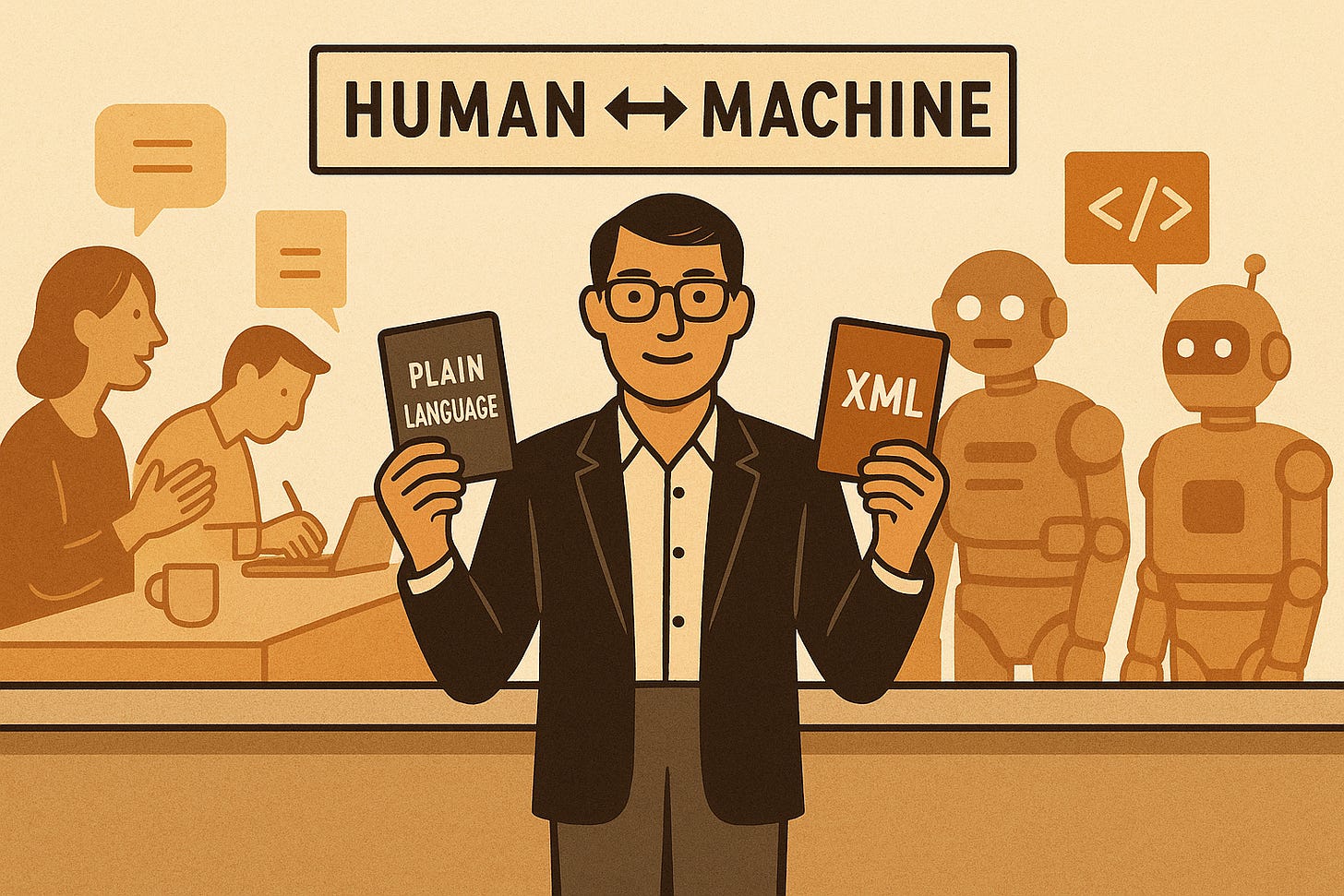 Image: ChatGPT
Image: ChatGPTWe’re Bilingual (and One of Those Languages Is XML)
We speak human. We speak machine. Sometimes, both are in the same sentence.
We can explain to developers why their UI labels don’t make sense and then turn around and explain to execs why their chatbot is hallucinating because the source content is garbage.
This ability to translate chaos into coherent strategy? That’s a superpower. And it’s precisely what’s needed to get people to care about content problems that are otherwise invisible until something explodes (usually late in the day on a Friday).
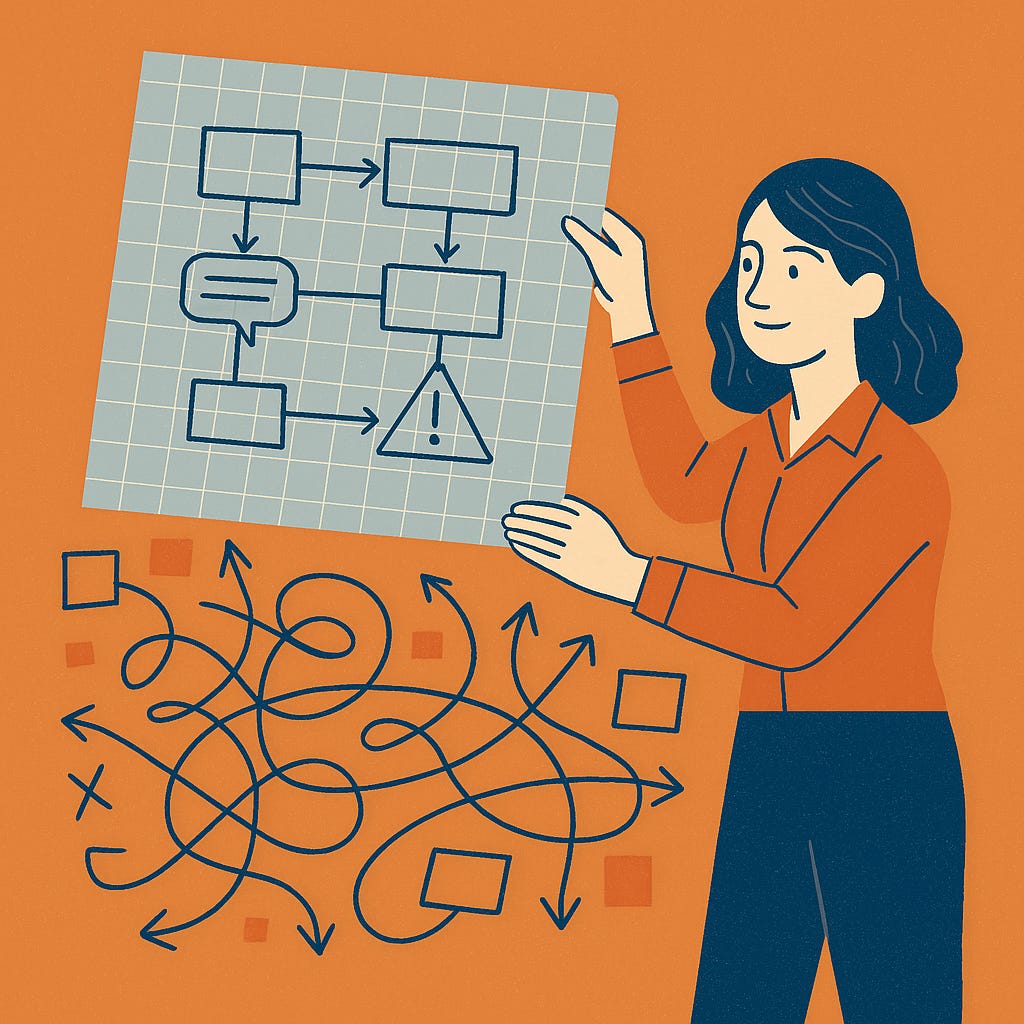 Image: ChatGPT
Image: ChatGPTWe Can Make the Invisible Gloriously Visible
Good content is like good Wi-Fi. You only notice it when it’s not working.
So, let’s make the consequences of bad content impossible to ignore:
Repetitive support tickets about the same missing steps
Global customers waiting weeks for translated updates
Engineers explaining the same thing in Slack ‚ again and again
Then, let’s show what happens when content is supported:
Tickets drop
Launches speed up
Reviewers stop weeping
You don’t need a PhD in data science. Just tally up the hours you spend doing the same thing over and over. That’s your ROI, right there.
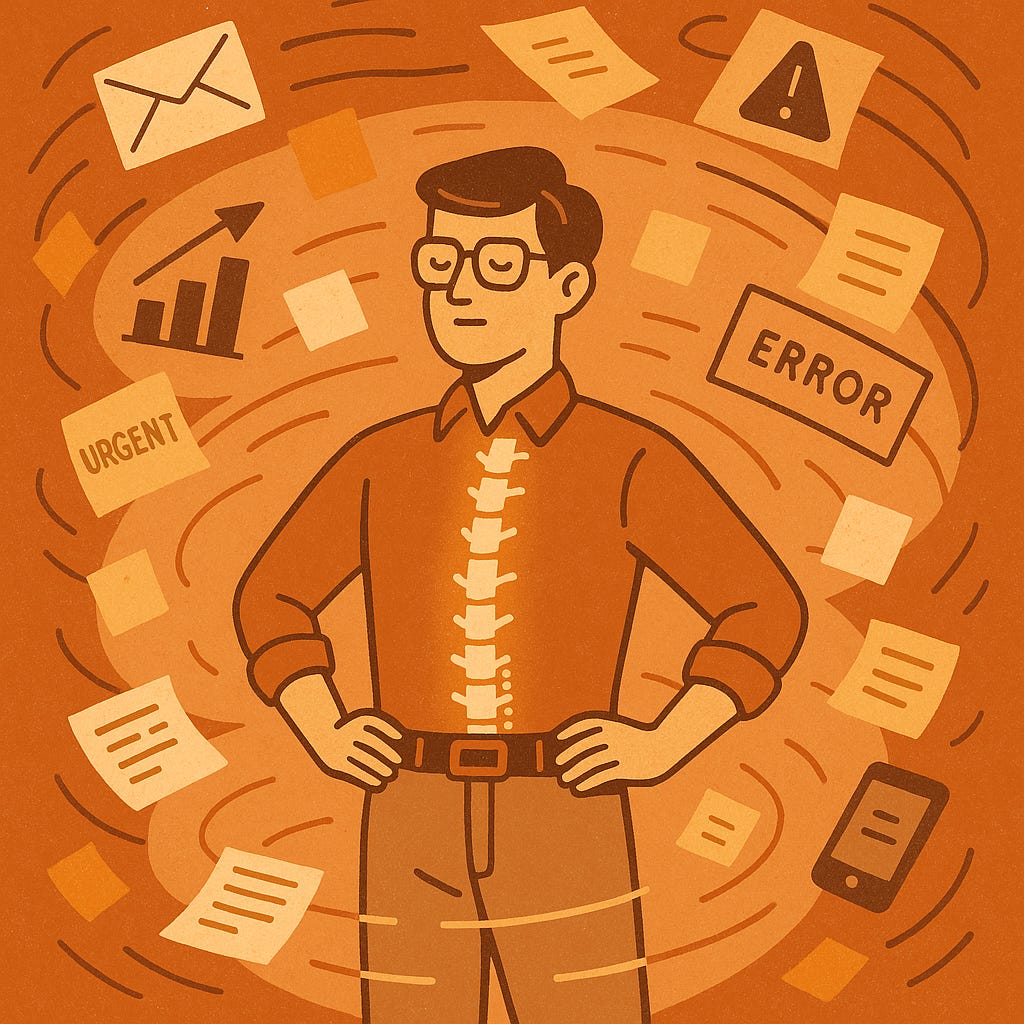 Image: ChatGPT
Image: ChatGPTWe Don’t Need a Title to Lead—Just a Spine
We don’t have a “Senior Vice President of Content Optimization Strategy and Global Enlightenment” in our email signatures.
But we have something better: credibility.
People trust us. They come to us to make sense of nonsense. That means we already have a seat at the table—even if it’s one of the folding chairs off to the side.
So, let’s use our credibility to pitch ideas that improve things. Let’s get bold enough to say: “Hey, if we fix this, maybe we won’t have to spend our Fridays re-exporting 14 help topics because the logo changed by one pixel.”
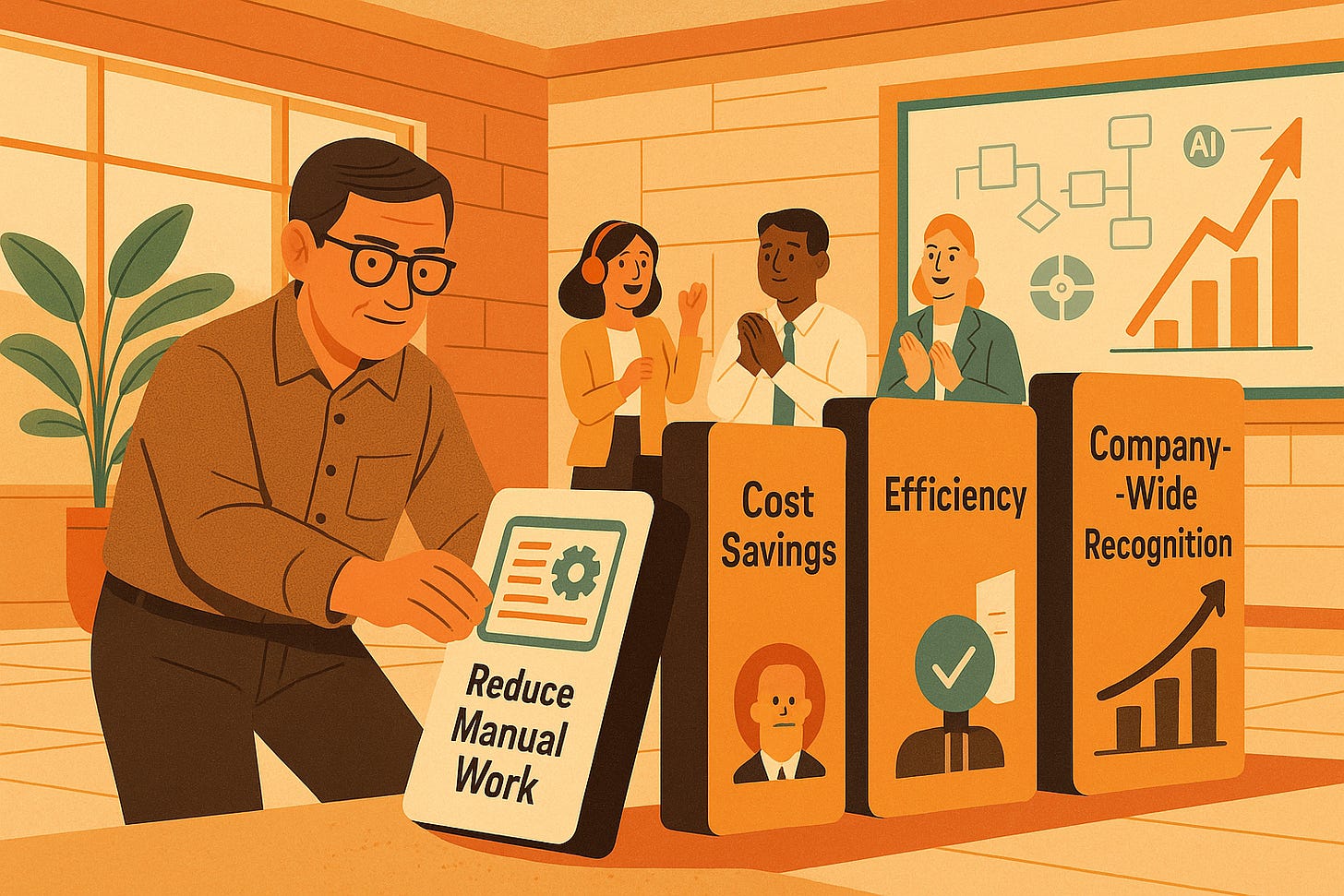 Image: ChatGPT
Image: ChatGPTWe Can Start Small and Still Win Big
Here’s how to begin your journey as a business case cheerleader without breaking out in hives:
✅ Identify the recurring pain. What do we complain about on Slack the most? That’s your project.
✅ Find your allies. Who else is sick of it? Support? Localization? Sales? Pull them in. Make it a movement.
✅ Tie it to something shiny. Is the company launching AI features? Expanding internationally? Link your content improvements to those significant, budget-worthy initiatives.
✅ Talk dollars and hours. “Fixing this will save us 250 hours and cut our translation costs by 30%.” No one ignores that sentence.
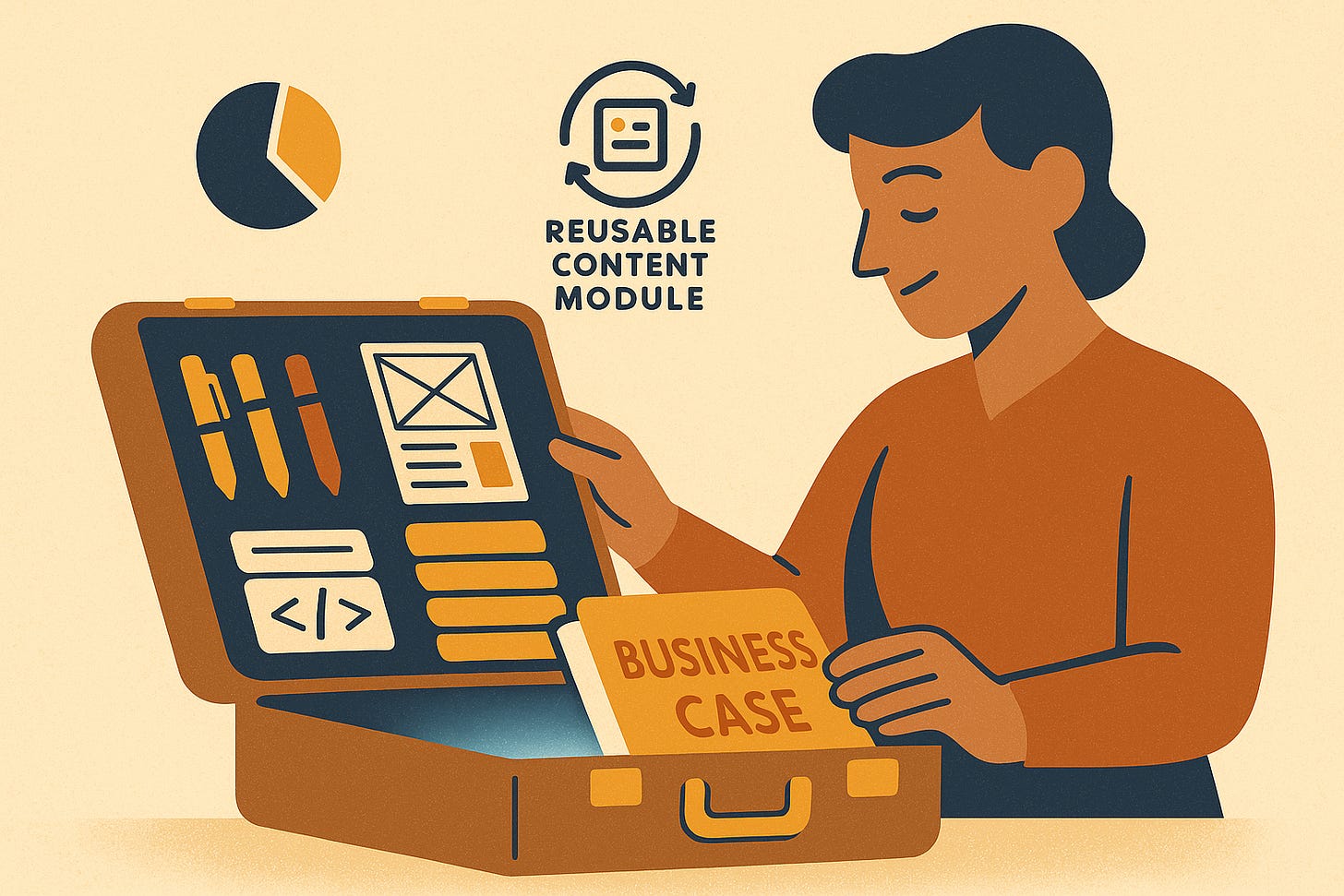 Image: ChatGPT
Image: ChatGPTLet’s Fight For Better Content
If we don’t fight for better content, who will?
Carl from Accounting? Please.
We are the ones with the receipts. The ones who know how bad it is and how good it could be.
So, let’s stop whispering about our content woes and start waving the flag. Let’s turn our frustration into action. Let’s write the kind of business case that makes a VP say, “Wait—we’re not already doing this?”
Because we’re not just writers.
We’re advocates.
We’re translators.
We’re professional dot-connectors.
And honestly? We’re kind of tired of doing the same workaround for the 100th time. 🤠
Correcting some outdated "Learning SPARQL" examples
Scroll, Click, Comply: How AI Slop Greases the Gears of Techno?Fascism
You know that reel where a chipper robot voice narrates a Reddit breakup over Subway Surfers footage? The one you swipe past while convincing yourself this is “research”? That’s not harmless background noise—it’s rehearsal footage for a political movement that prefers spectacle to substance and uniformity to thought.
RattleSnake Studio says it out loud in their video “AI Slop, Technofascism, and You.”
The Content Wrangler is a reader-supported publication. To receive new posts and support my work, consider becoming a free or paid subscriber.
Watch this video on YouTube and share it with others.
AI Slop, Technofascism, and You
Wait—what exactly is “AI slop”?
AI slop is mass‑produced, low‑effort, AI‑generated junk—text, video, images—optimized for engagement metrics, not truth or usefulness. Think of it as content feedlot runoff: plenty of volume, zero nutrition.
Tech reporters and search pros are already using the term to describe the flood of machine-made filler clogging social and search results.
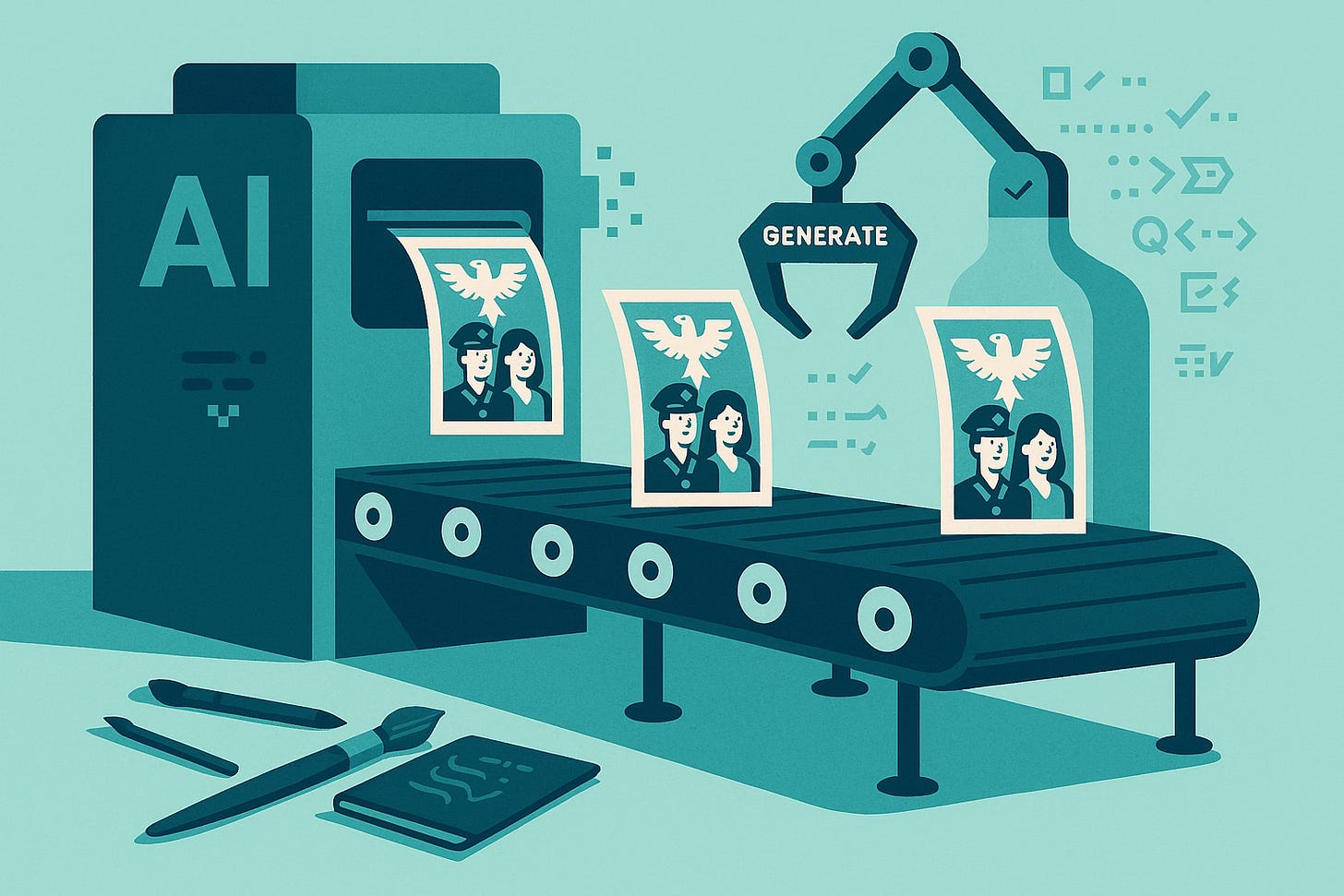
Fascism Runs on Aesthetics And AI Delivers Aesthetic-On-Demand
Walter Benjamin warned that fascism “aestheticizes politics”—it gives people goosebumps instead of rights. It turns power into a pageant while leaving the power structure intact.
Historically, fascist regimes curated a narrow visual vocabulary—heroic bodies, pastoral nostalgia, mythic pasts—and censored or criminalized artists who colored outside the lines. The Nazis literally staged a “Degenerate Art” show to ridicule work that didn’t fit the template, while centralizing “acceptable” imagery through a propaganda ministry.
Enter generative AI: a machine built to remix templates and crank out nostalgic pastiches at scale.
Uniformity? Check.
Backward-looking mythos? Easy.
Speed over nuance? Built in.
No need to wrangle opinionated artists with pesky ethics when you can just prompt your way to a thousand glossy Rockwell knockoffs, extra fingers included.
 Image: ChatGPT
Image: ChatGPTBut I Write Release Notes, Not Manifestos, So, Why Should I Care?
Because documentation is how organizations tell the truth about what their products do, what users can and can’t do, what’s broken, and what’s at stake. When low-effort AI slurry seeps into doc sets, you don’t just annoy readers—you erode trust, blur authorship, and normalize myth-making. Your style guide becomes a speed bump, not a guardrail.
Authoritarian movements don’t just target “capital A” Artists. They go after anyone who controls narratives, defines terms, or keeps receipts. That’s you.
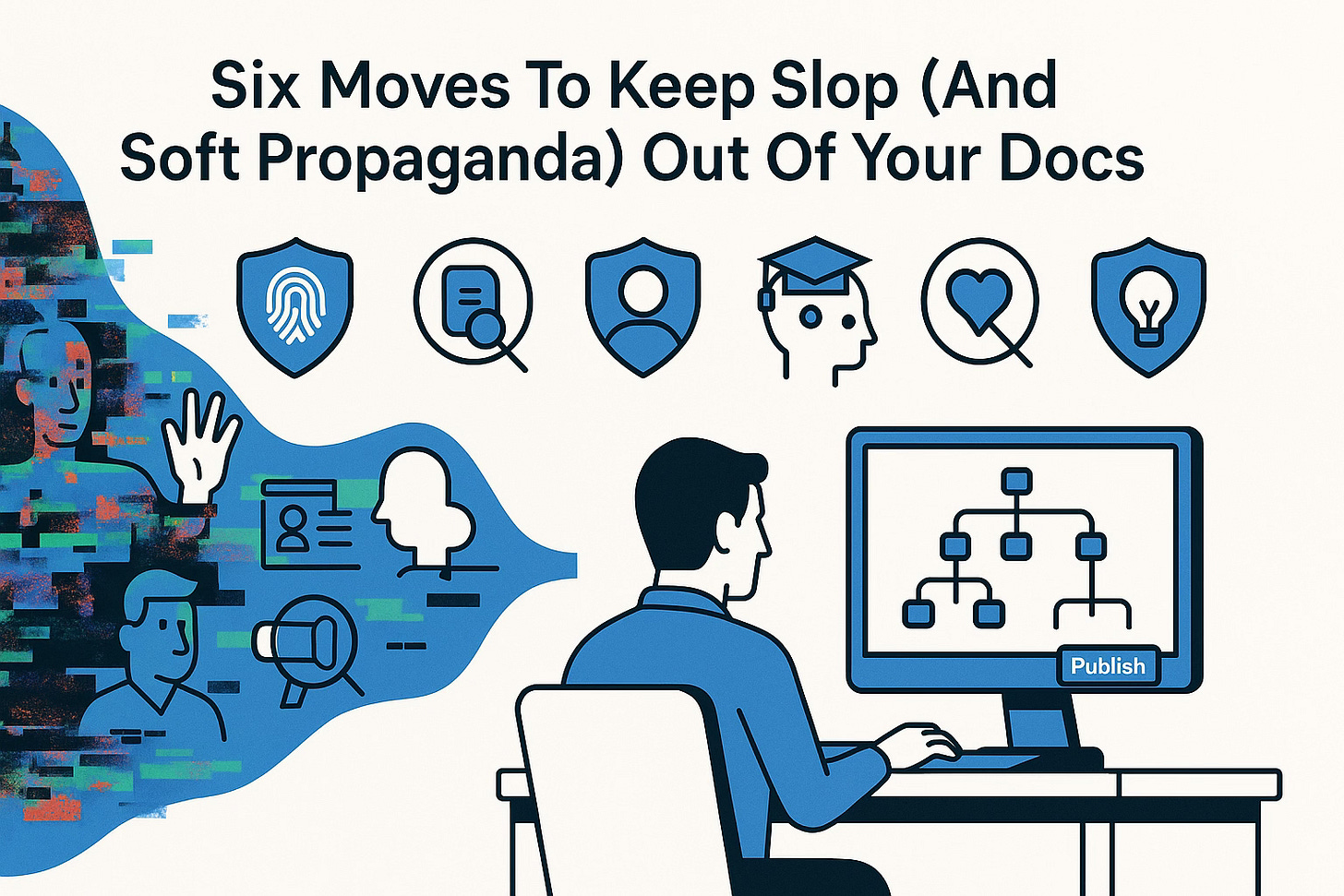
1. Provenance or it didn’t happen
Bake source, authorship, and review metadata into your content model. Who wrote it, who reviewed it, what model (if any) helped, when it was last fact-checked—make that machine-readable and auditable.
2. Institute an “AI Slop Check”
Before you ship anything generated or assisted by AI, ask:
Does this add anything new, or just remix clichés?
Can every factual claim be traced to a verifiable source?
Can I point to a human who stands behind this? If the answer is “uhhh,” you’re looking at slop. Fix it or kill it.
3. Document reality, not just requirements
The RattleSnake video urges creatives to connect the personal and the political, to show real human stakes. In docs, that means capturing actual user scenarios, edge cases, and consequences—not just the happy path marketing wants. Propaganda loves a vacuum; fill it with verifiable detail.
4. Myth filters in your workflow
Structured authoring plus governance = fewer unsupported claims. Require citations or subject matter expert sign-off for every “we’re the first,” “industry-leading,” or “everyone knows” sentence. Schedule periodic audits for marketing creep.
5. Teach your team to spot the tells
Host short, repeatable trainings on:
Common AI artifacts (those weird hands, uncanny phrasings, generic “inspirational” tone)
How deepfakes and synthetic text spread
Your internal rules for when AI is allowed and how it’s disclosed
6. Keep the hope (and humor) alive
Fascism’s endgame is compliance through despair. Authentic voice, honest status pages, and humane UX writing keep readers oriented—and remind them humans are still in the loop. That matters more than you think.
A Quick (And Reusable) Pre‑Publish Checklist
Human in the loop? Named reviewer approved it
Source trail visible? Every fact has a link you’d defend in public
Original value? Solves a user problem, not just fills a Jira ticket
Model disclosure? Which tools were used, and how
Inclusive & accurate? No in‑group mythologizing, no nostalgia gloss
Versioned? Easy rollback if an “auto-improve” feature degrades meaning
Copy, paste, stick it in your CMS workflow. Tattoo it on your product owner if necessary.
The Takeaway
AI isn’t evil. And, slop isn’t inevitable. But fascism loves a shortcut, and generative tech hands it the keys: infinite spectacle, zero accountability. Our counter is boringly heroic: receipts, rigor, reality—told by humans, for humans.
Keep making real human documentation. Keep telling true stories. Keep that pilot light on. 🤠
The Content Wrangler is a reader-supported publication. To receive new posts and support my work, consider becoming a free or paid subscriber.
DeepL expands real-time voice translation capabilities
Bloomreach and Snowflake partner
BrowserStack launches Accessibility Design Toolkit
TileDB announces partnership with Databricks to harness multimodal data
Call for Presenters: DITA Europe 2026

I hope you'll join me in Brussels at Hotel Le Plaza Brussels, February 2-3, 2026, for DITA EUROPE 2026 — the conference for technical writers and information developers looking to build advanced information management and delivery capabilities. If your technical documentation team produces content using the Darwin Information Typing Architecture (DITA) — or you’re considering doing so ‚ this is the conference for you.
Call for presenters
The call for presenters is open now. If you've got a case study, best practices, or lessons learned to share, the conference organizers want to hear from you.
👉🏼 Submit your proposal (Sept 1, 2025 is deadline).
And, if you decide to attend, you can save 10% off the cost of registration using discount code — TCW — at checkout.
DITA Europe is brought to you by the Center for Information Development Management, (CIDM) — a membership organization that connects content professionals with one another to share insights on trends, best practices, and innovations in the industry. CIDM offers networking opportunities, hosts conferences, leads roundtable discussions, and publishes newsletters to support continuous learning. CIDM is managed by Comtech Services, a consulting firm specializing in helping organizations design, create, and deliver user-focused information products using modern standards and technologies.
The Content Wrangler is a reader-supported publication. To receive new posts and support my work, consider becoming a free or paid subscriber.
Why Your Technical Documentation Team Needs an API-Driven CCMS
If you’re a technical writer, you probably have a love-hate relationship with your content management system (CMS). On a good day, it’s your best friend who helps you organize, publish, and maintain documentation. On a bad day, it’s like trying to communicate with an old fax machine that only speaks Klingon.

Let's face it — documentation doesn't exist in a vacuum. It needs to connect with the rest of your company's tools to stay relevant and valuable. If you've ever wished your CMS could play nice with those tools—congratulations — you're already thinking about API-driven architecture!
The Content Wrangler is a reader-supported publication. To receive new posts and support my work, consider becoming a free or paid subscriber.

What Is '“API-Driven,” Anyway?
API-driven means that a system isn't a walled garden—it's an open, flexible platform that communicates with other software through Application Programming Interfaces (APIs).
Imagine your CMS as a restaurant. In a traditional setup, customers (users) can only get what's on the menu (built-in features). However, An API-driven restaurant allows customers to send in their ingredients and have the chef cook something custom.
For technical documentation teams, an API-driven Component Content Management System (CCMS) lets you connect your content to the rest of your tech stack. That means your documentation doesn't have to live in isolation—it can interact with support ticketing systems, version control repositories, customer relationship management (CRM) platforms, and more.
Related: API-driven architecture, simplifying software development
The Benefits of an API-Driven CCMS
Integration with Other Tools (Because No One Likes Copy-Pasting)
Manually moving content between platforms can quickly become a nightmare. With an API-driven CCMS, you can automatically push documentation updates to customer service tools like Zendesk or Salesforce, ensuring that support agents always have the latest information—no more frantic emails begging someone to update a knowledge base article.
Automation for the Win
If your documentation team follows a Docs-as-Code workflow, an API-driven CCMS can integrate with version control systems like Git or GitHub. When a developer updates the codebase, your docs can automatically reflect those changes. No longer will you need to chase down engineers to ask, "Wait, did we release that feature?"
Dynamic Content Delivery
Static documentation is so 2010. With API-driven content, you can serve up personalized, real-time documentation that updates based on user data. Imagine a chatbot that pulls live documentation from your CCMS, or a mobile app that displays different help articles based on the user's permissions.
With dynamically delivered self-service content, customers can fix their problems anytime. As tech evolves, this isn’t a bonus—it’s the new normal, reshaping what “customer support” means.
Related: Is Disorganized Content Making Your Chatbot Look Bad?

Scalability Without the Headaches
As your documentation needs grow, an API-driven system makes it easy to integrate with new platforms without a complete overhaul. Want to pull in analytics from Looker Studio or push updates to a Learning Management System (LMS)? An API-driven CCMS can make it happen with minimal effort.

Security and Compliance
If your company deals with sensitive information, APIs help ensure your documentation follows security best practices. You can integrate Single Sign-On (SSO) for authentication or set up API-based audit logs to track changes and access history.

Real-World API Integrations That Make Your Life Easier
Here are just a few of the services that you might want to connect to your API-driven CCMS:
Zendesk – Keep your support articles in sync with your documentation.
Salesforce – Serve up relevant documentation directly in CRM workflows.
GitHub/GitLab/Bitbucket – Automate documentation updates when code changes.
Slack – Get notifications when content is updated or reviewed.
Confluence – Sync content between your CCMS and internal knowledge bases.
Google Analytics – Track how users interact with your documentation.
Chatbots – Provide real-time answers based on live documentation.
Related: How to Nail Single-Source Publishing
Wrapping It Up (Without a TL;DR Cop-Out)
If your documentation team is spending more time managing content than actually writing it, it's time to consider an API-driven CCMS like Heretto. By integrating with your company's existing tools, you can streamline workflows, automate updates, and ensure your content reaches the right people at the right time.
The Content Wrangler is a reader-supported publication. To receive new posts and support my work, consider becoming a free or paid subscriber.
[2?Minute Poll] Is Your Technical Documentation Ready For Right?To?Repair?
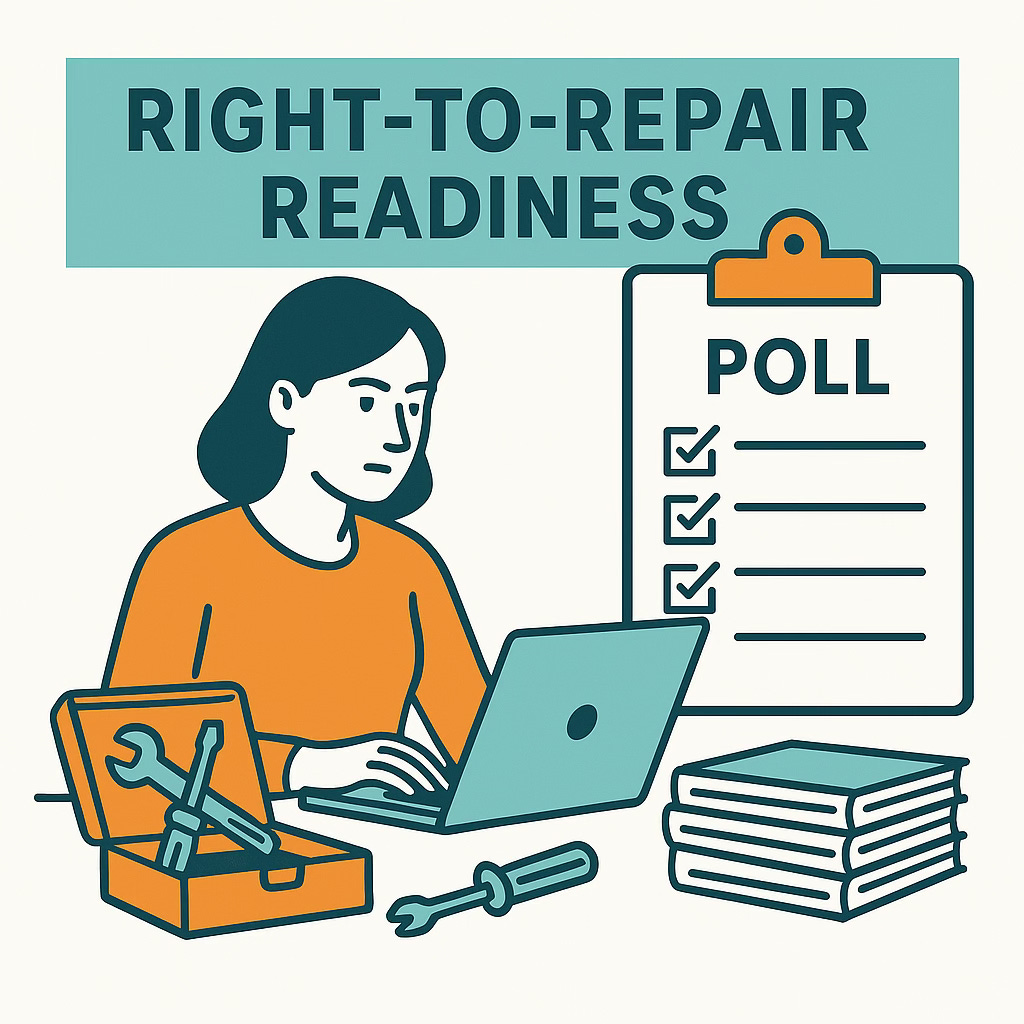
Right‑to‑Repair laws keep expanding—Oregon’s tough electronics law took effect on Jan 1, 2025 and legislators in more than 40 States are considering similar requirements. These rules make technical documentation a compliance hotspot.
To see how prepared our community is, I’ve put together a short, anonymous Right‑to‑Repair Readiness Poll (five questions, under two minutes).
Take the poll
See also:
The Content Wrangler is a reader-supported publication. To receive new posts and support my work, consider becoming a free or paid subscriber.
Data Requirements For Digital Product Passports
All digital product passport (DPP) information requirements under the Ecodesign for Sustainable Products Regulation (ESPR) must be purposeful and relevant. Each data element should have a well-defined scope and deliver a tangible benefit for users at different stages of the product's life cycle.
The ESPR outlines that a DPP must include the following types of data, as well as any additional "voluntary data" that supports digitized and streamlined information-sharing processes.
 Image: ChatGPT
Image: ChatGPTProduct Identification
Includes product name, model number, serial number, and other distinguishing features. A unique identifier is essential for connecting the physical product with its associated digital information.
Materials
It covers all materials used throughout the product's life, including their origins, the availability of critical raw materials, and material flow data.
Product Design
Designers and engineers transform materials into the final product configuration, including details on material flow and other relevant aspects.
 Image: ChatGPT
Image: ChatGPTTechnical Specifications
Includes performance characteristics and technical parameters such as power consumption, size, weight, and other relevant metrics.
Product Lifecycle
Defines the sequential stages of a product's existence, from raw material extraction to end-of-life treatment.
Installation and Maintenance
Provides comprehensive guidance on how to install, use, maintain, and repair the product—including third-party software where applicable.
Material Composition
Details the inclusion of recycled and renewable materials within the product.
Microplastics
Information on the potential release of microplastics or nanoplastics during manufacturing, use, or disposal.
Environmental Impact
Reports on the product's carbon footprint, material footprint, and other relevant environmental effects.
 Image: ChatGPT
Image: ChatGPTRepair and Replacement
Offers data on spare parts, compatibility of components, and modular design, along with non-destructive disassembly procedures for repairs and replacements.
Reuse and Recycling
Explains how users can reuse, remanufacture, or recycle materials to promote circularity and reduce waste.
Product Maintenance History
Includes records of service events, repairs, and upgrades, as well as maintenance schedules.
Warranty Information
Outlines the terms and conditions of the warranty, including what is covered and for how long.
Energy Recovery
Covers methods for generating energy from the product through incineration, including heat recovery from combustible waste.
 Image: ChatGPT
Image: ChatGPTSubstances of Concern
Identification: Lists the substance name, identification codes (IUPAC, EC number, CAS number), location in the product, and concentration levels.
Usage and Handling: Offers safe handling instructions, disassembly procedures, and protocols for managing hazardous substances.
Lifecycle Tracking: Includes procedures for monitoring substances of concern across the product's lifecycle.
End-of-Life Management: Provides guidance on disassembly, recycling, and safe disposal of hazardous materials, including reuse, refurbishment, and remanufacturing options.
Why Technical Writers Need To Understand Digital Product Passports
If you’re a tech writer and you’ve never heard of the EU’s new Digital Product Passport (DPP) requirement, you’re not alone. It hasn’t exactly made front-page news on Technical Communication Monthly (if that were a thing—it’s not). But make no mistake, this new regulation, introduced by lawmakers in 2022, it took effect in 2024, with major rule‑setting actions (working plan, standards) are expected by December 2025. Full implementation is anticipated by 2030.
Why Does This Matter To Tech Writers?
The DPP requirements will change how we create, share, and manage product information. If you think these requirements don't apply to you because you live or work in the United States—or anywhere not covered in metric measurements—you might want to sit down. This regulation isn’t just some Eurocratic experiment in circular economics. It’s a global wake-up call—and technical communicators everywhere need to listen.
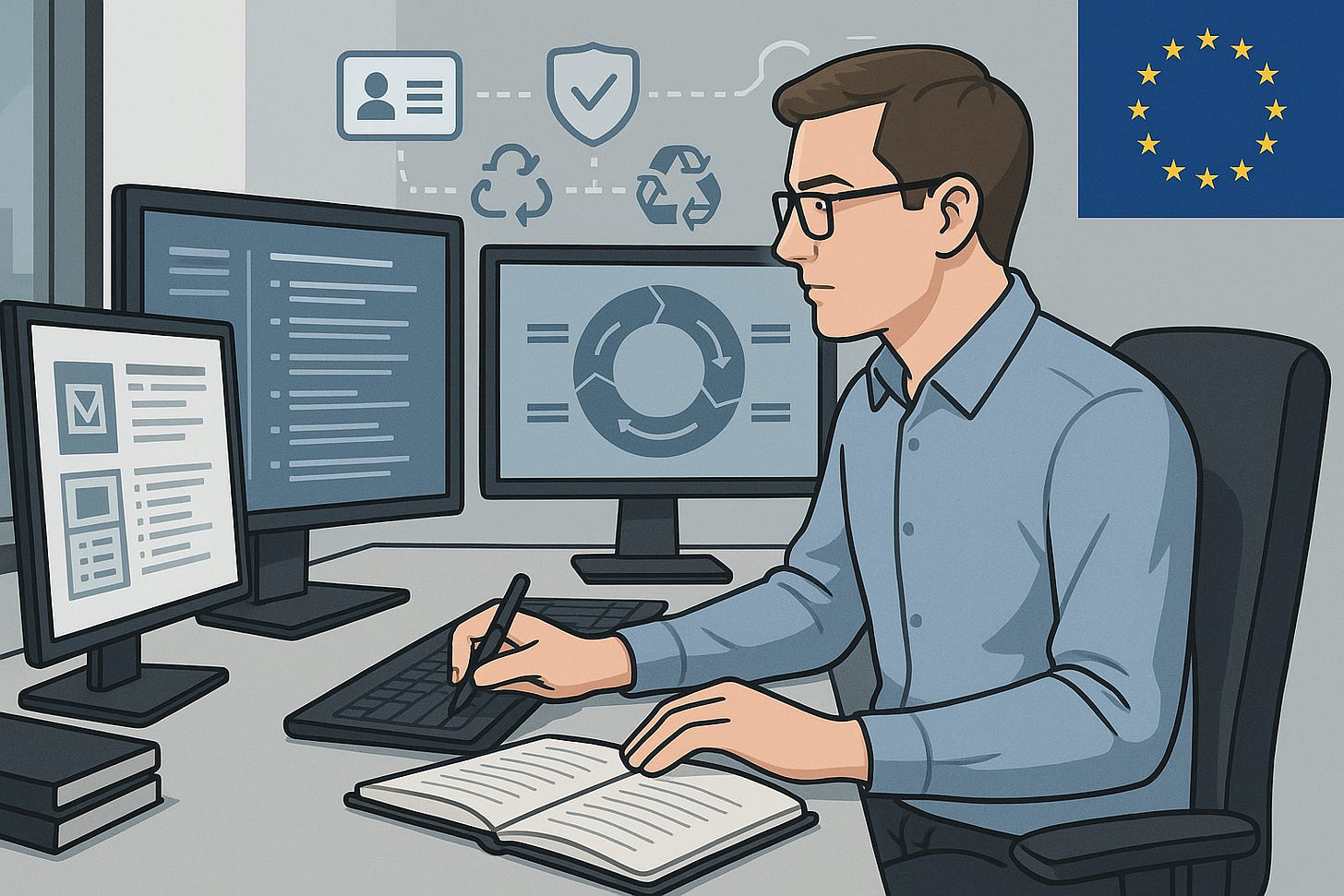 Image: ChatGPT
Image: ChatGPTSo… What Is a Digital Product Passport?
Think of a DPP as a digital file cabinet stapled to your product (digital, of course), full of standardized, machine-readable facts about what’s in it, how it was made, how to fix it, and how to dispose of it without setting the Earth on fire.
DPPs are part of the EU’s push for a circular economy—a polite way of saying “we’d like to stop drowning in e-waste and polyester.” These passports will be required for a range of products, starting with batteries and electronics and expanding to textiles, furniture, and more.
Why Should You Care?
Because if your company sells products into the EU—or plans to—you’re going to need to generate this data. And guess who’s already sitting on a pile of that information, or at least knows where it lives?
That’s right. You. The technical writer.
The person who already documents material content, safety specs, repair steps, and take-back instructions—only now, you’ll need to do it in a structured, standardized format designed for machines and humans. (Don’t worry, robots still can’t proofread.)
Even if your product never crosses the Atlantic, chances are your company’s regulatory, sustainability, or marketing teams are paying attention. Because once the EU sets the bar, other countries tend to follow. (see also: GDPR panic of 2018.)
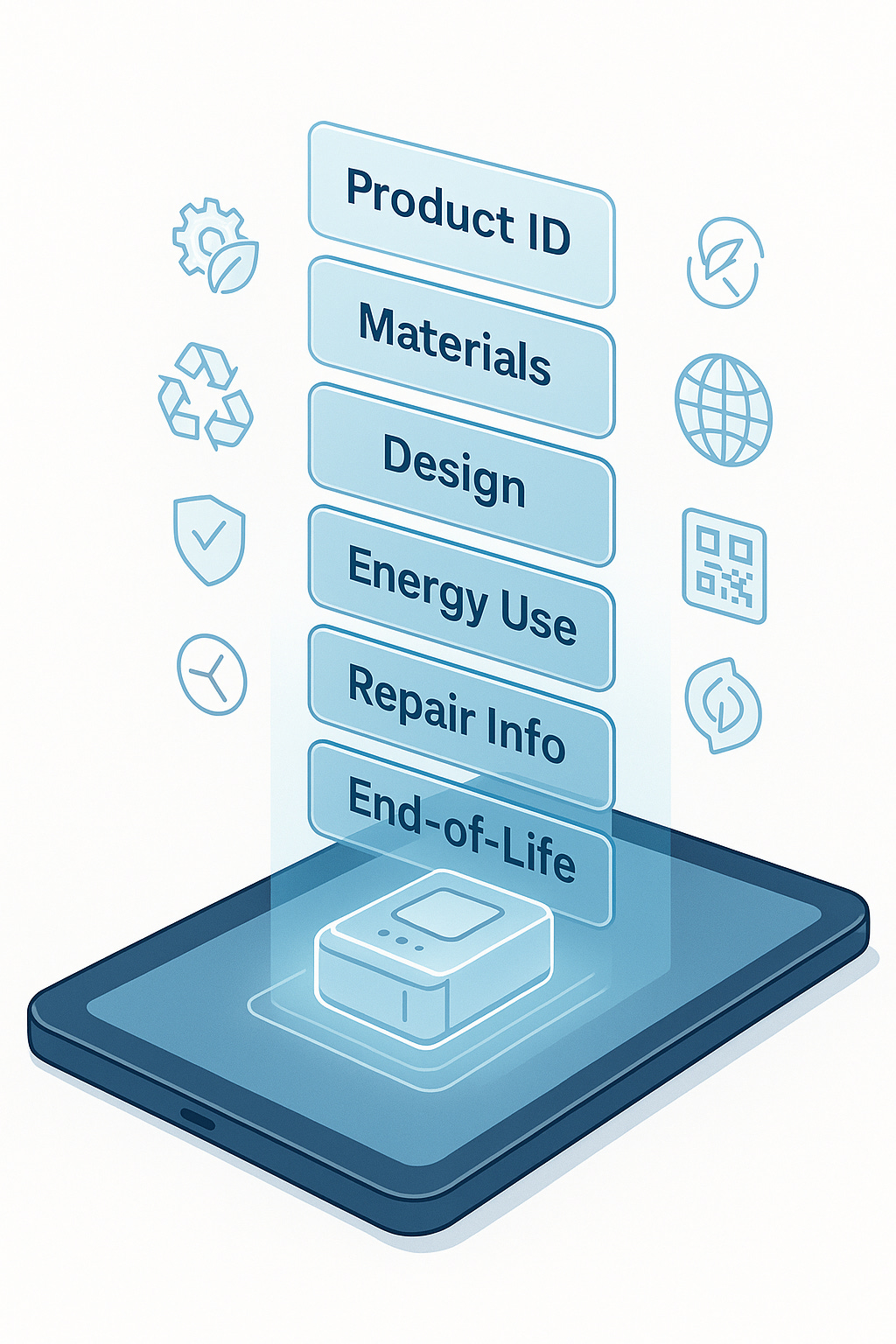 Image: ChatGPT
Image: ChatGPTWhat’s In a DPP, Anyway?
You’re Not Just a Writer—You’re a Translator for the Machine Age
In the past, we wrote for people—real, living, blinking humans who clicked, skimmed, and sometimes said thanks (usually when something broke). But now? Now we're writing for a split audience: the human on one side and a tireless army of robots on the other. These bots don't sleep, they don't eat, and they don't appreciate your clever pun in paragraph three.
So what's a technical writer to do when your job description quietly expands to include "AI whisperer" and "SEO sorcerer"? This post is your survival guide.
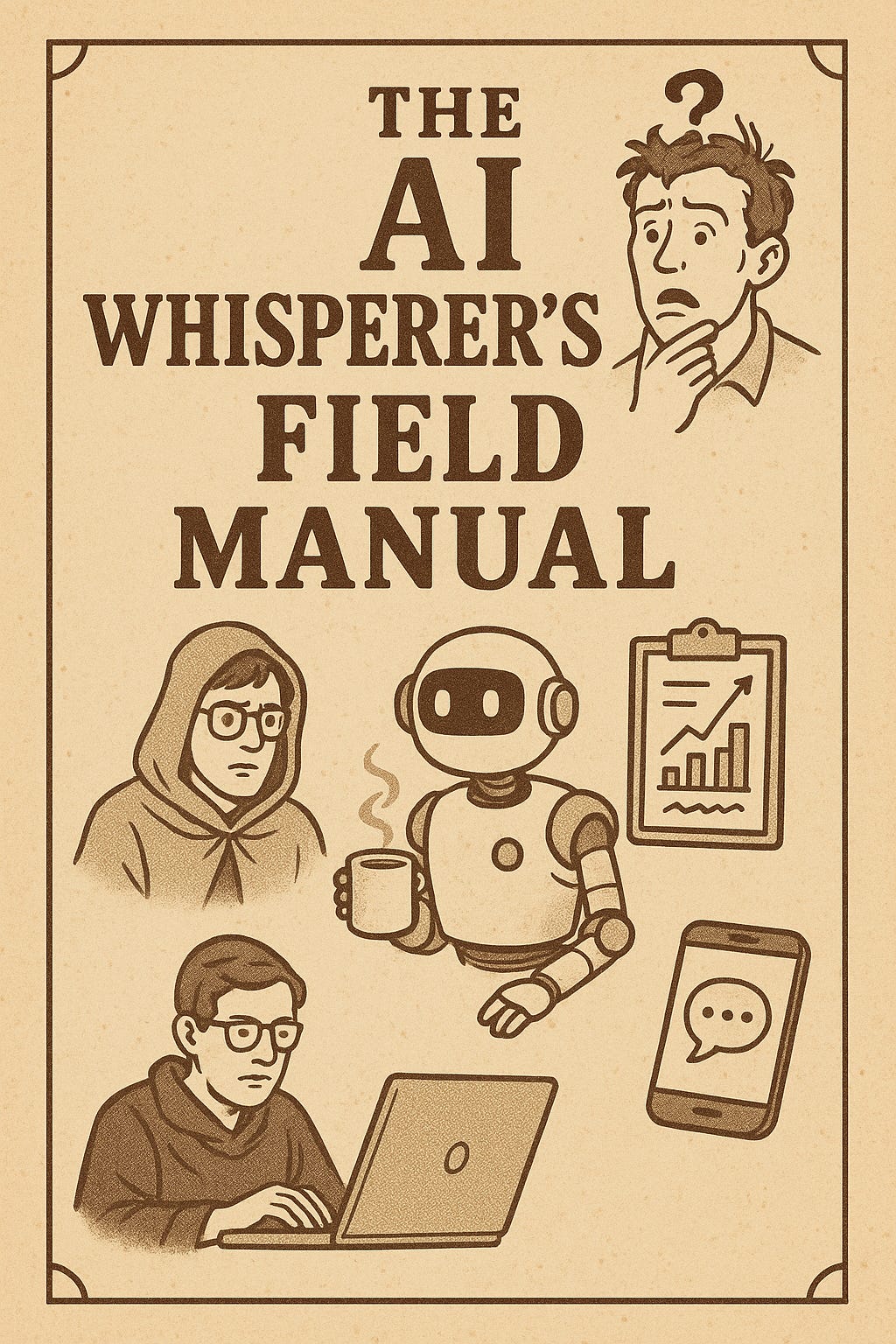 Image: ChatGPT
Image: ChatGPTThe New Audience: Humans, Crawlers, and Language Models
Three groups now read your content: the human who needs help fast, the search engine crawler that indexes your page, and the large language model (LLM) that spits out your words in someone else's chatbot session. All three are trying to understand what your content is about. If it's not clear, they'll get confused, make things up, or move on. Think of them like houseguests: keep things tidy, label the snacks, and don't make them hunt for the bathroom.
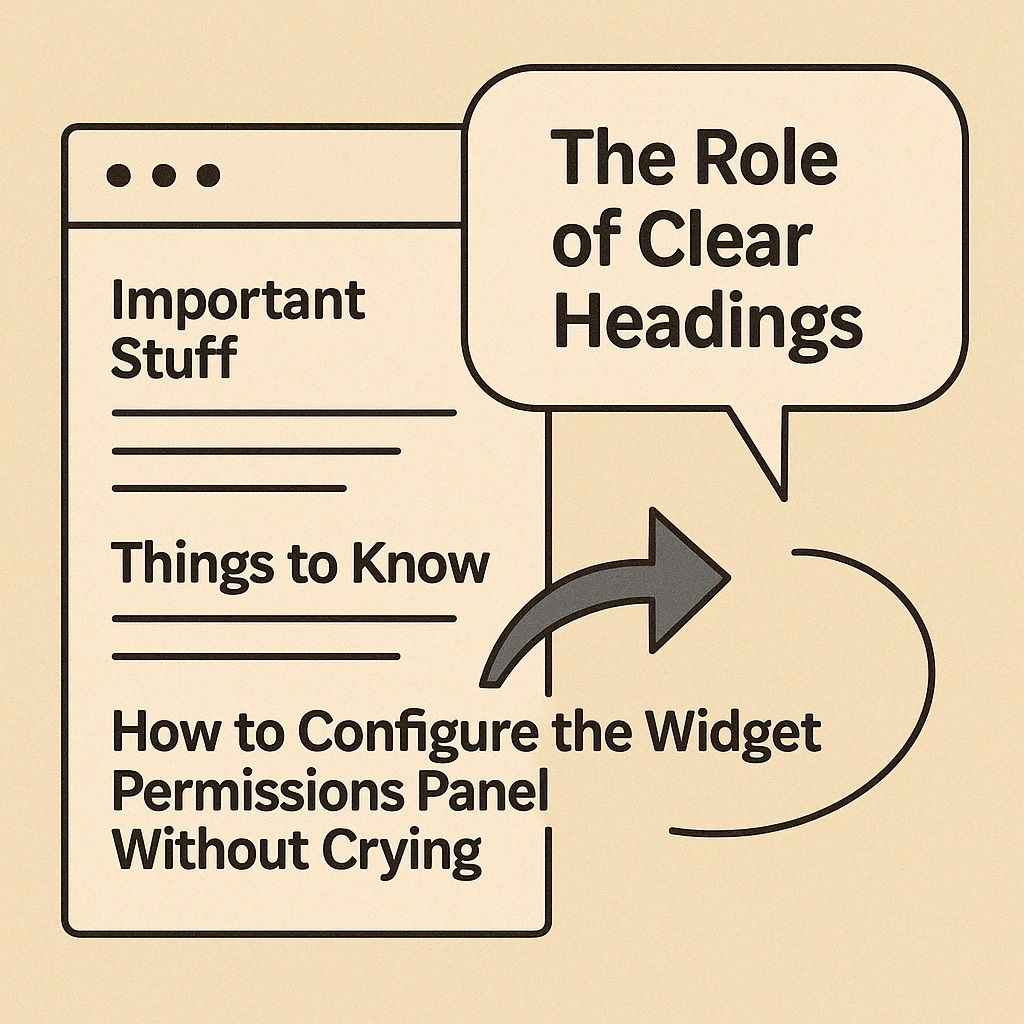 Image: ChatGPT
Image: ChatGPTThe Role of Clear Headings
Headings aren't decoration—they're navigation. Clear, consistent, logical headings help both humans and machines know what to expect. They act as signals: "This section explains setup." "This part solves a specific problem."
Don't get artsy or vague. "Things to Know" won't cut it. "How to Configure the Widget Permissions Panel Without Crying"—now that's helpful. Give readers and bots a map, not a maze.
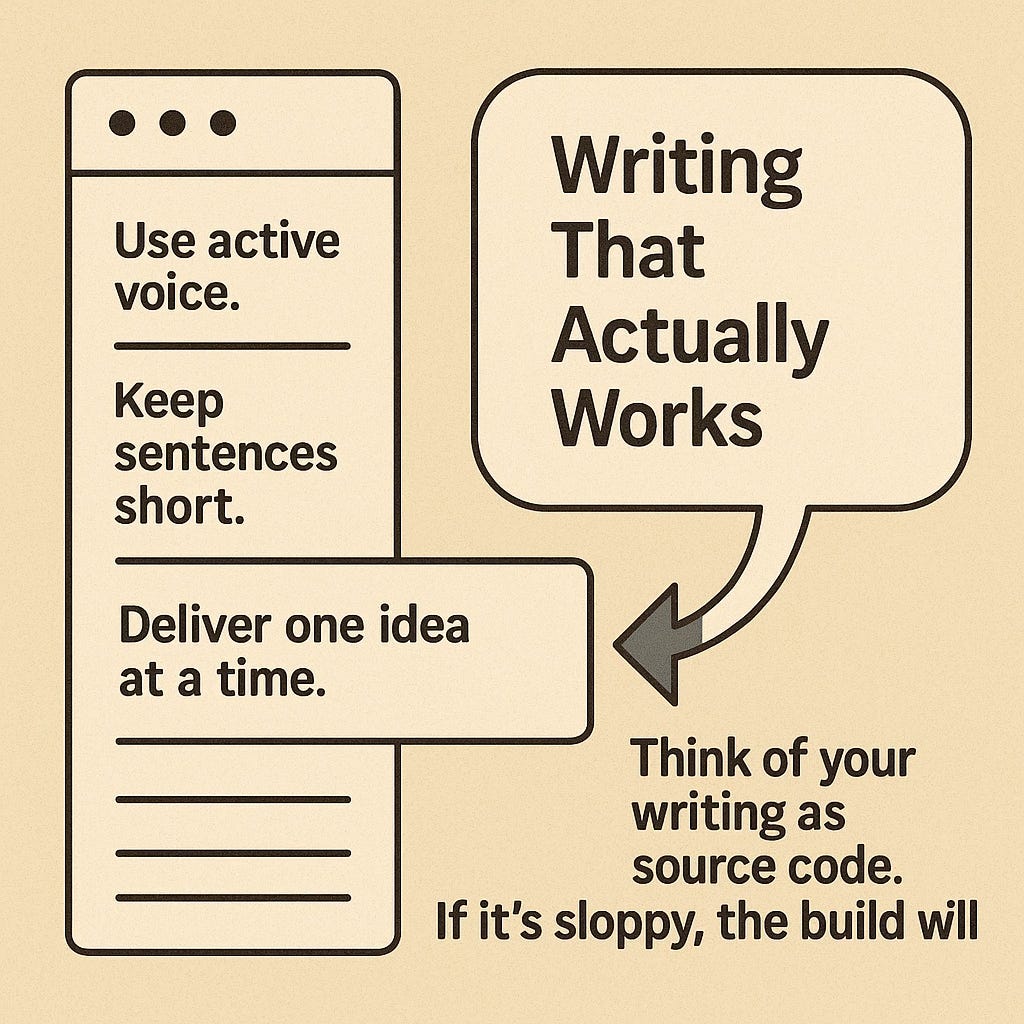
Writing That Actually Works
Use active voice. Keep sentences short. Deliver one idea at a time. You're not just writing for people—you're writing for machines that will rephrase, summarize, and remix your content in ways you didn't intend. If your sentence sounds like it came from a committee with a thesaurus addiction, expect it to land weird when paraphrased.
Think of your writing as source code. If it's sloppy, the build will fail.
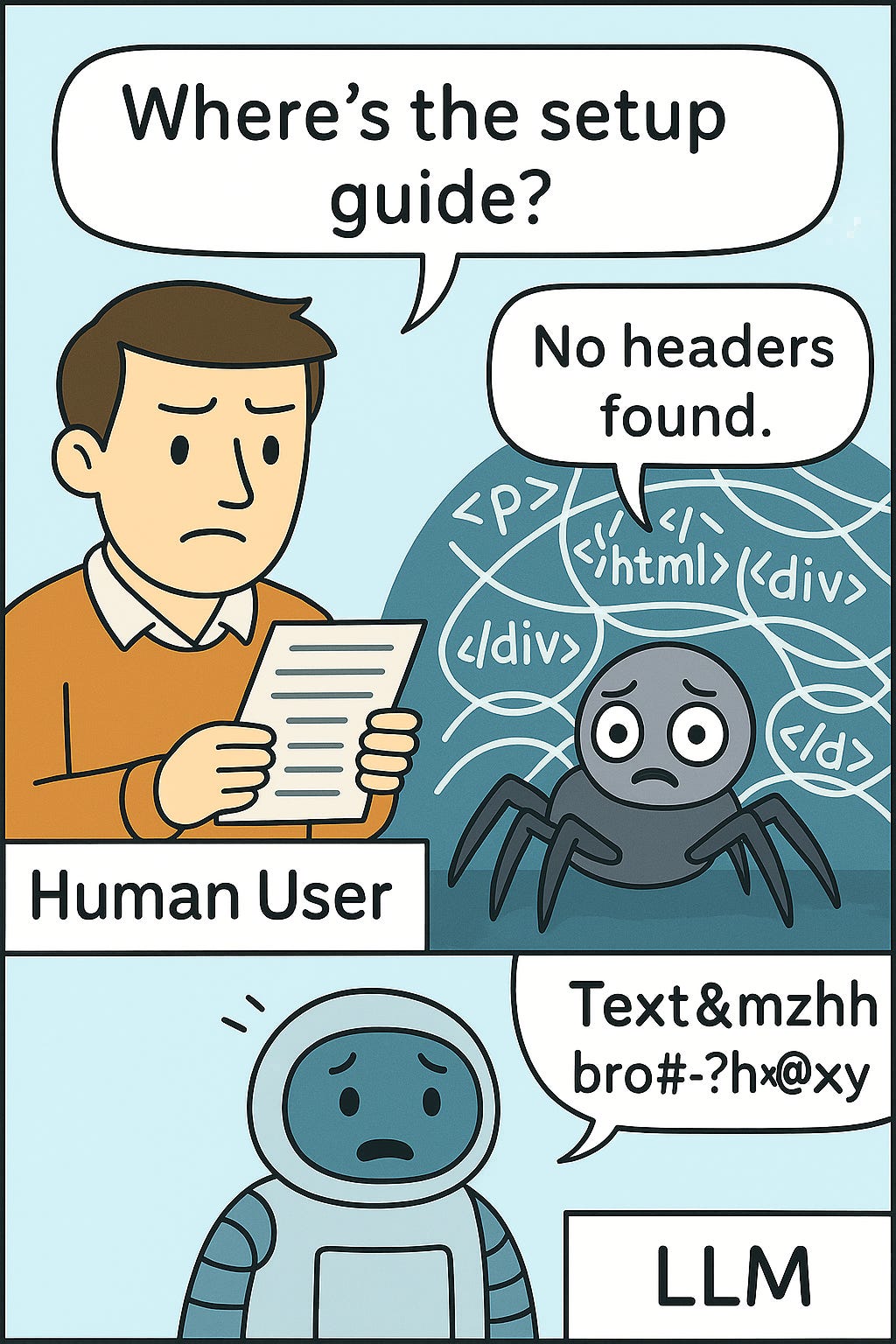 Image:ChatGPT
Image:ChatGPTMetadata, While Invisible, It's Also Mighty
Metadata is what helps machines understand what your content really is. Your page title, meta description, image alt text, and tags whisper clues to crawlers and models alike. Don't settle for auto-filled nonsense like "Page 1."
That's the digital equivalent of labeling your spice rack with "stuff."
Use structured data when you can. Schema markup makes it easier for machines to categorize and serve your content correctly. Robots love structure the way librarians love the Dewey Decimal System.
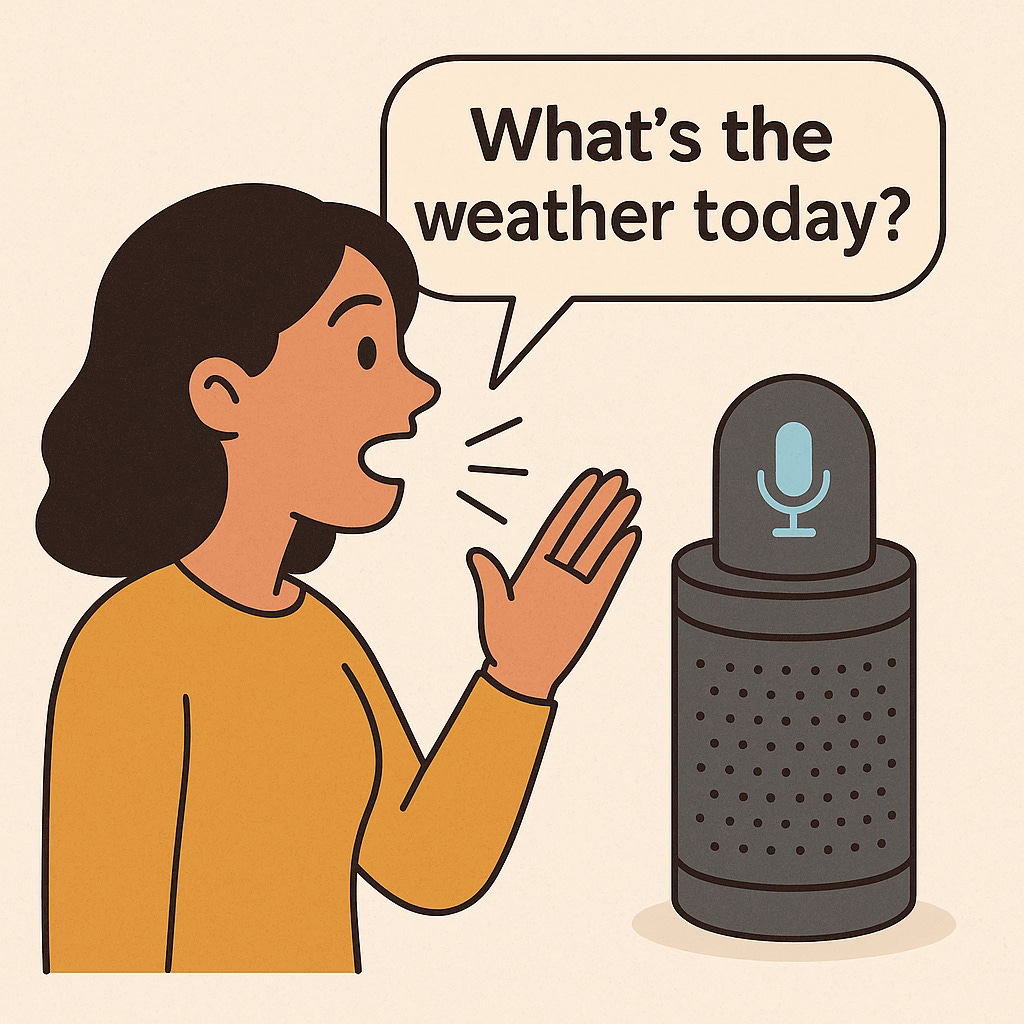 Image: ChatGPT
Image: ChatGPTWrite for Voice, Not Just Eyes
Keywords are still helpful, but you're seasoning, not stuffing. Avoid awkward repetition and focus on sounding human. Many users now ask questions out loud, so write like you're answering them in conversation.
Use natural phrasing. Cut the jargon unless you're sure it's part of your audience's vocabulary. Speak to both the voice assistant and the person shouting at it.
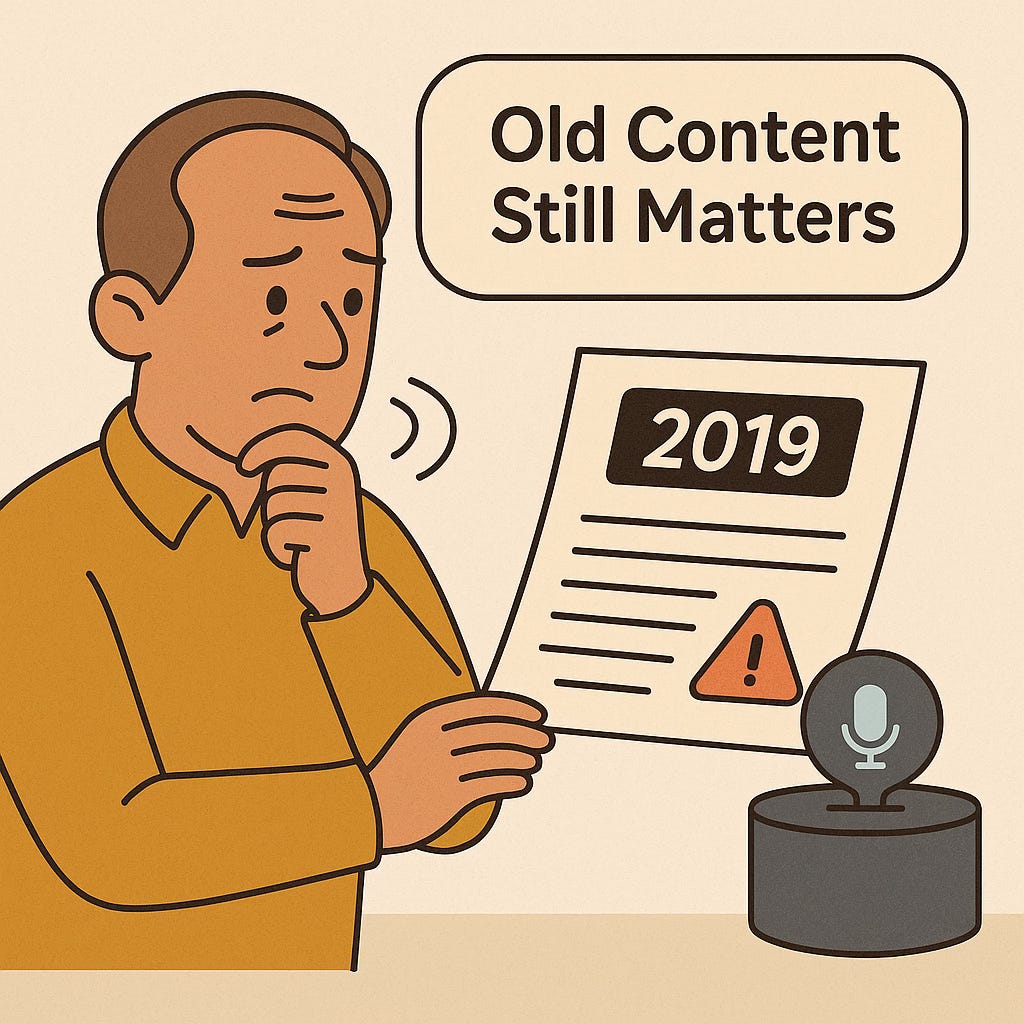 Image: ChatGPT
Image: ChatGPTOld Content Still Matters
Just because you wrote it years ago doesn't mean it's retired. LLMs don't care about freshness—they'll pull from that dusty 2019 how-to if it's still floating around. If it's outdated, it may provide incorrect information to someone who trusts it.
Review your older content regularly. Fix links. Update details. Clarify anything that might age poorly. A little maintenance goes a long way when the audience includes time-traveling AI.
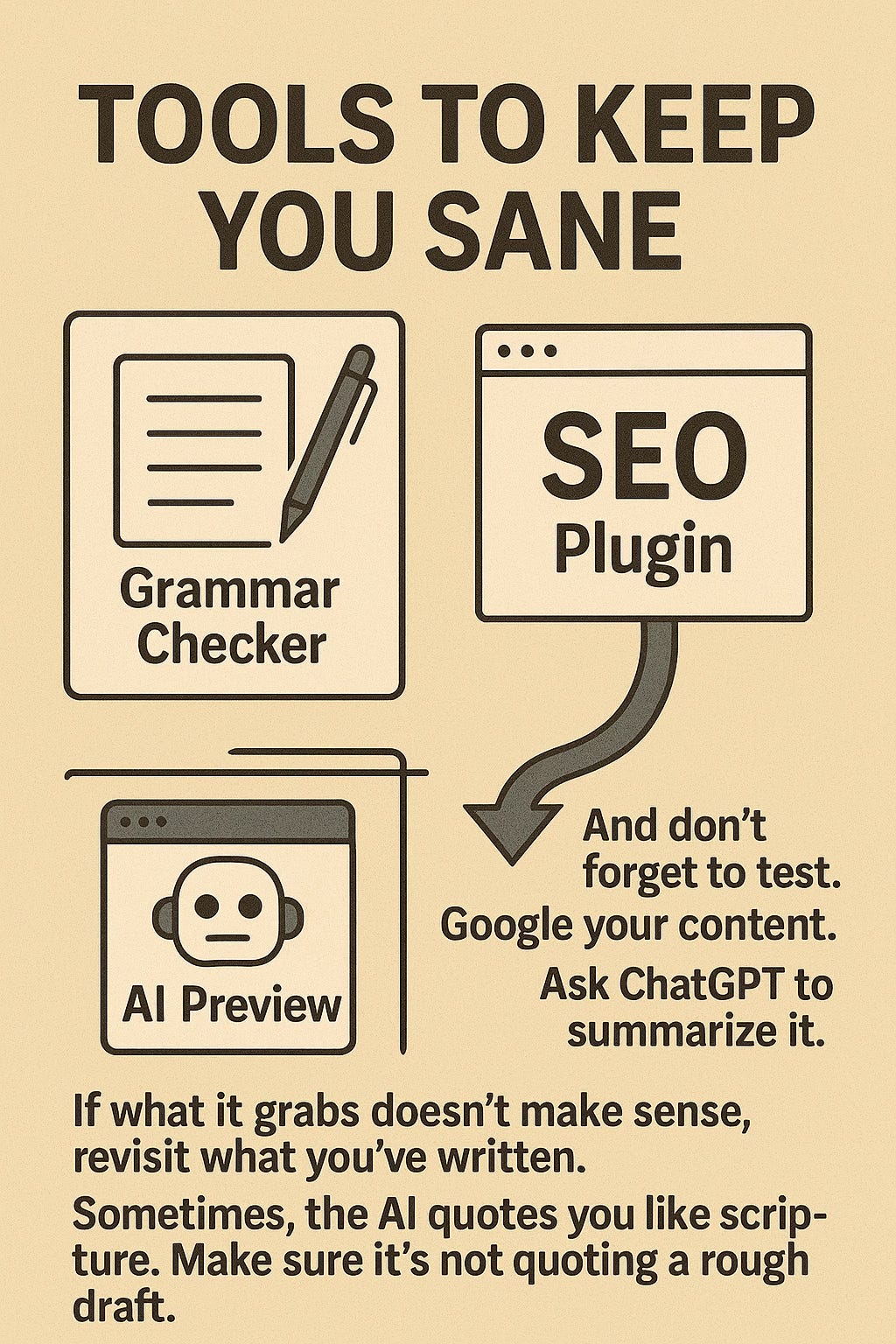 Image: ChatGPT
Image: ChatGPTTools to Keep You Sane
Use tools that help you bridge the human-robot gap. Grammar checkers to catch drift. SEO plugins to highlight opportunities. AI preview tools that show what a chatbot might pull from your content.
And don't forget to test. Google your content. Ask ChatGPT to summarize it. If what it grabs doesn't make sense, revisit what you've written.
Sometimes, the AI quotes you like scripture. Make sure it's not quoting a rough draft.
You're Not Just a Writer—You're a Translator for the Machine Age
You're bridging the gap between human need and machine logic. Between the question someone asks at 2 AM and the answer that floats back in a chatbot's voice.
It's not easy. But neither is writing documentation for software that ships while you're still editing the release notes.
Write with care. Structure like a librarian. And when in doubt, imagine you're explaining it to both your future self and an extremely literal alien with a search engine for a brain.
Got tips? Mistakes? Robot horror stories? Share them in the comments. Misery, after all, loves metadata.
Why Your Customer Journey Map Might Be Leading You Straight Into a Ditch
I once tried mapping out my career journey on a whiteboard. It started strong—college, first job, some light existential dread—but by the third marker color, it devolved into something resembling a subway map drawn by a raccoon with a Red Bull problem.
That, my friends, is how most customer journey maps end up: overly optimistic at first, then quickly unraveling into chaos and assumptions.
And yet, if you're a technical writer, someone probably waved a journey map in front of you at some point and said, "This is where your content fits in." It's like summing up your entire contribution to the customer experience in a tidy box labeled "Post-Purchase Onboarding PDF."
So, let's discuss how customer journey mapping can go wrong, especially when tech writers are not invited to the meeting until it's too late.
 Image: ChatGPT
Image: ChatGPT1. The Fantasy of the Linear Journey
You've seen that clean diagram in which a customer starts at awareness, gently floats through the consideration phase, gracefully landing at loyalty like a well-trained swan.
Reality check: people don't shop like they're on a conveyor belt at IKEA.
They loop, backtrack, get distracted by shiny objects, and rage-quit halfway through. If you don't account for detours, you plan your customer journey like a road trip using a 1984 Rand McNally atlas—without GPS or a clue.
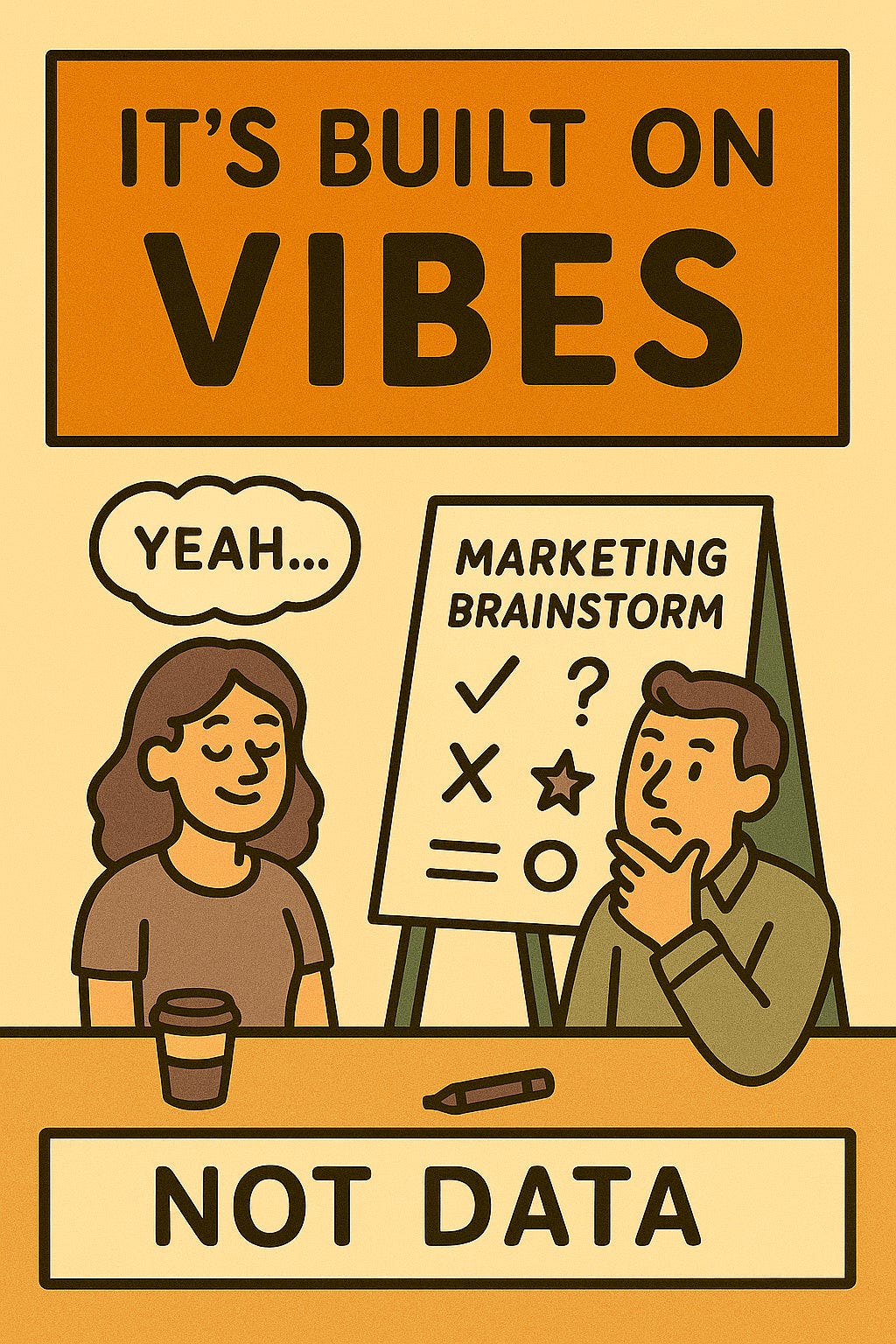 Image: ChatGPT
Image: ChatGPT2. It's Built on Vibes, Not Data
Some journey maps are less "customer insights" and more "vague recollections from a marketing brainstorm fueled by muffins."
If your map reflects what you think customers do instead of what they actually do, congratulations—you've created a piece of customer fiction.
Technical writers, you deserve better. Ask for real data: search queries, support tickets, behavioral heatmaps. Bonus points if someone on the team has spoken to a customer during the past decade.
 Image: ChatGPT
Image: ChatGPT3. Everyone Is One Dimensional
"Meet Sarah. She's a project manager who loves yoga and needs scalable documentation tools."
Cute. But also, no. 🙈
People don't exist as frozen archetypes. They're multitasking (okay, not really — but many believe they are), context-switching, sometimes grumpy beings whose needs change hourly. One minute, Sarah's researching your product; the next, she's trying to figure out why your documentation refers to three different UI labels for the same feature.
Don't write for cardboard personas. Write for people who are busy, tired, and want to know where the hell the settings panel moved to.
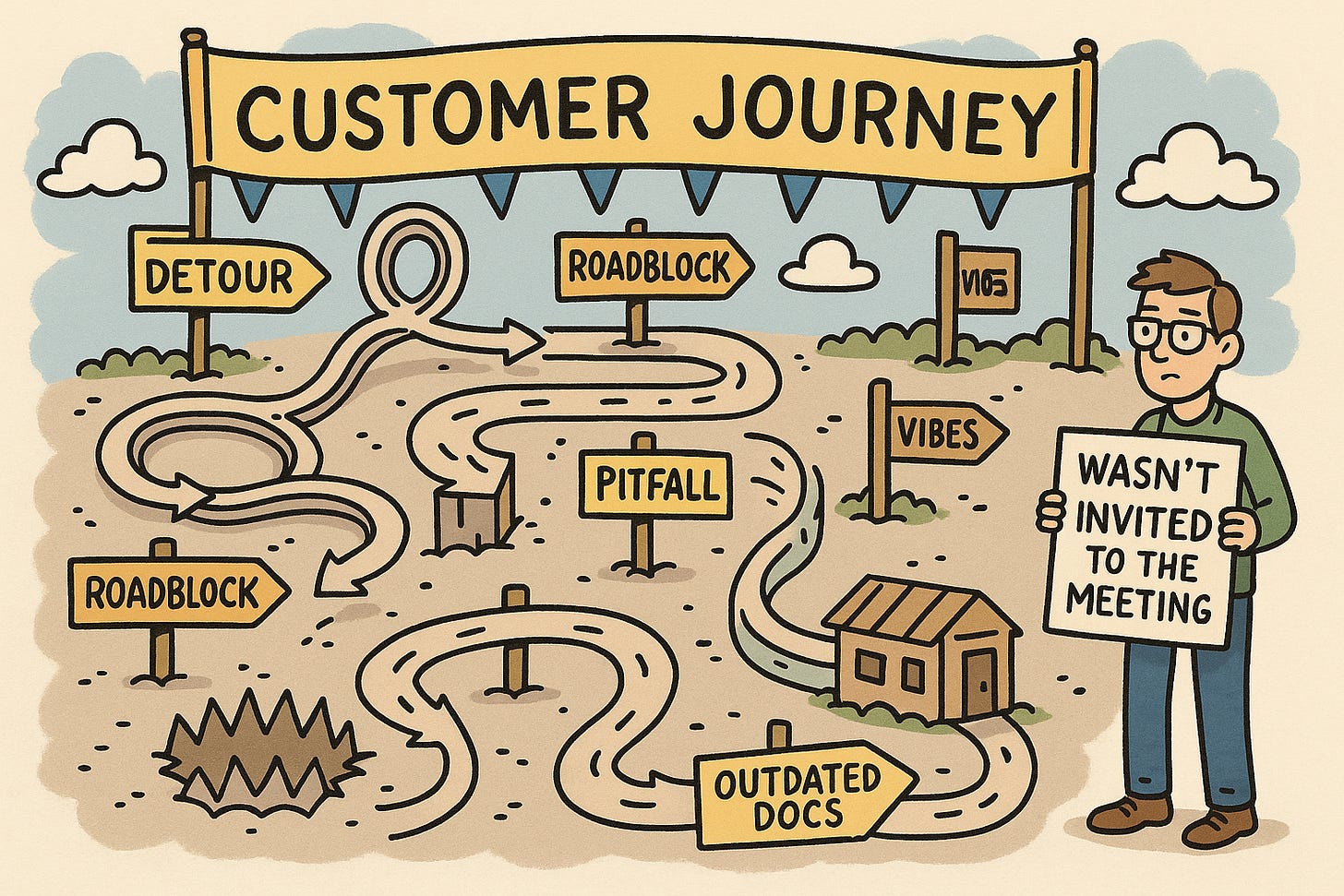 Image: ChatGPT
Image: ChatGPT4. No Writers in the Room
Well-intentioned teams create a lot of journey maps in workshop sessions filled with sticky notes, lattes, and absolutely no content people.
That's a mistake. A huge one.
Writers (and, by extension, customer support staff) know what users ask, where they get stuck, and how often they type "how to turn it off and back on again." Their absence from the mapping table means the voice of reason—and readability—is missing.
And guess who gets blamed when the help content doesn't magically solve everything?
 Image: ChatGPT
Image: ChatGPT5. It Ends at the Sale
Oh good, we've sold them the thing! Let's pack up and move on. Surely they'll never need help again.
Except… they will.
And if you don't map what happens after the sale—onboarding, troubleshooting, renewal—you're just designing a haunted house with no exits.
Don't let support content be an afterthought. That's your moment to shine.
 Image: ChatGPT
Image: ChatGPT6. It's Treated Like a Piece of Art
Some journey maps get framed. Literally. In hallways.
And then they're never updated again.
A journey map should be a living, breathing, occasionally grumpy document that changes when your product does. If yours still references that chatbot you retired in 2022, it's time for a refresh.
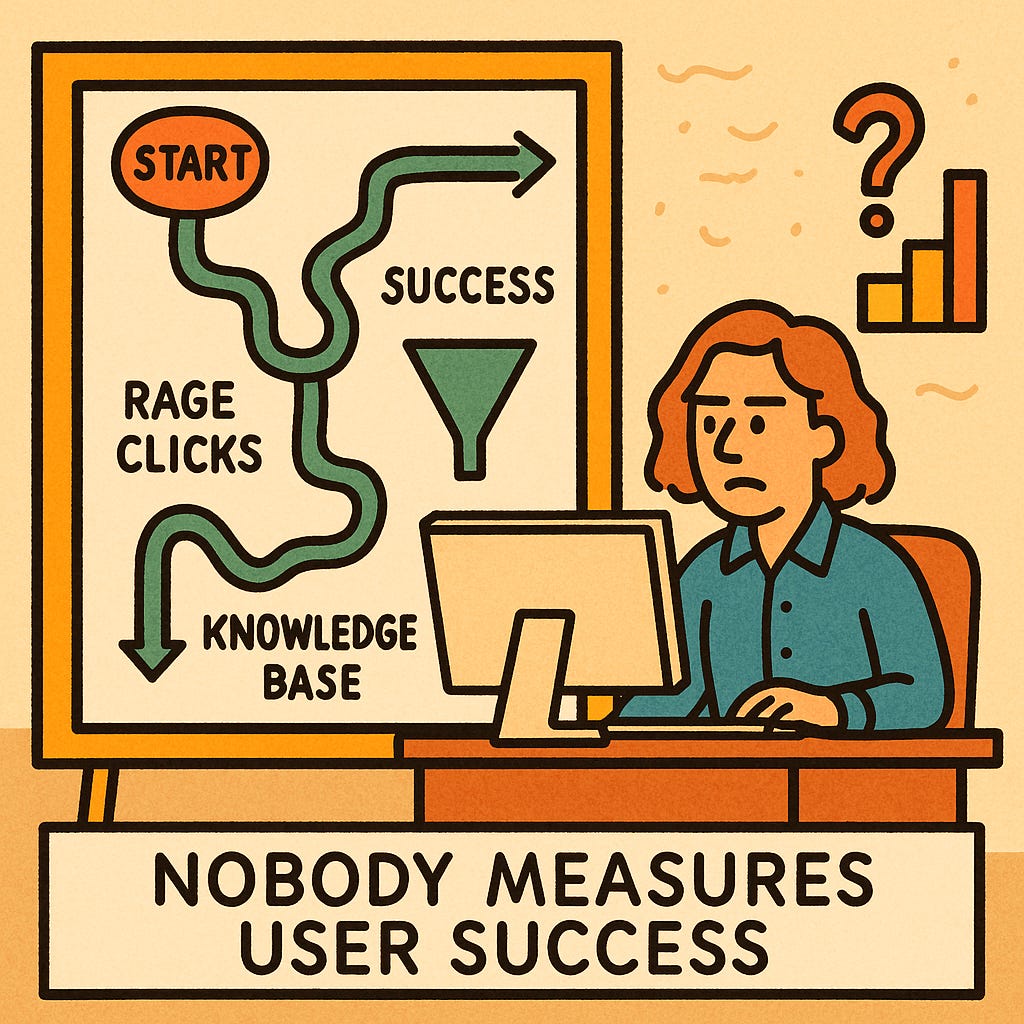 Image: ChatGPT
Image: ChatGPT7. Nobody Measures If It Works
Is the journey getting better? Are users actually succeeding? Or are they rage-clicking through your knowledge base like it owes them money?
If you're not tracking outcomes—or worse, can't track them because the content lives in twelve different tools with no analytics—your map is more aspiration than guidance.
Final Thought (Before You Add Another Sticky Note)
If customer journey maps are going to be useful, they have to be honest. Messy. Real.
Most importantly, they have to include content that actually helps customers succeed. That's where you come in, dear technical writer.
Remember the journey is complex, but your contribution doesn't have to be an afterthought. You're not just writing documentation. You're plotting the breadcrumbs that help customers find their way out of the dark forest. Preferably without screaming. 🤠
Upcoming Webinars:
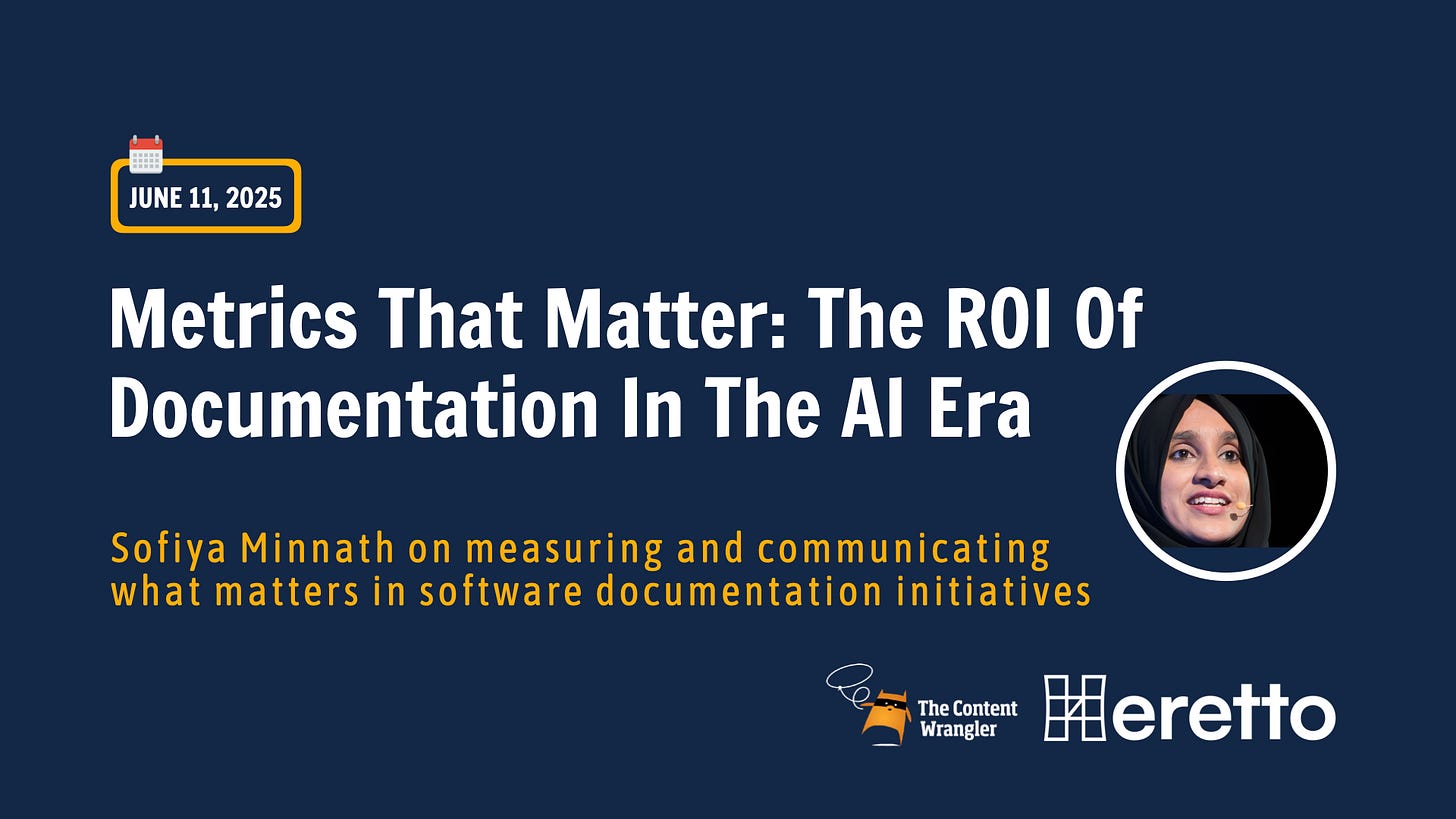
Metrics That Matter: ROI Of Documentation In The AI Era
🗓️ June 11, 2025 — 8am PT
👉🏼 Register
Join Sofiya Minnath ZA, Senior Manager of Growth Engineering at fabric.inc, as she delves into innovative metrics that go beyond traditional KPIs to demonstrate the real value of documentation.
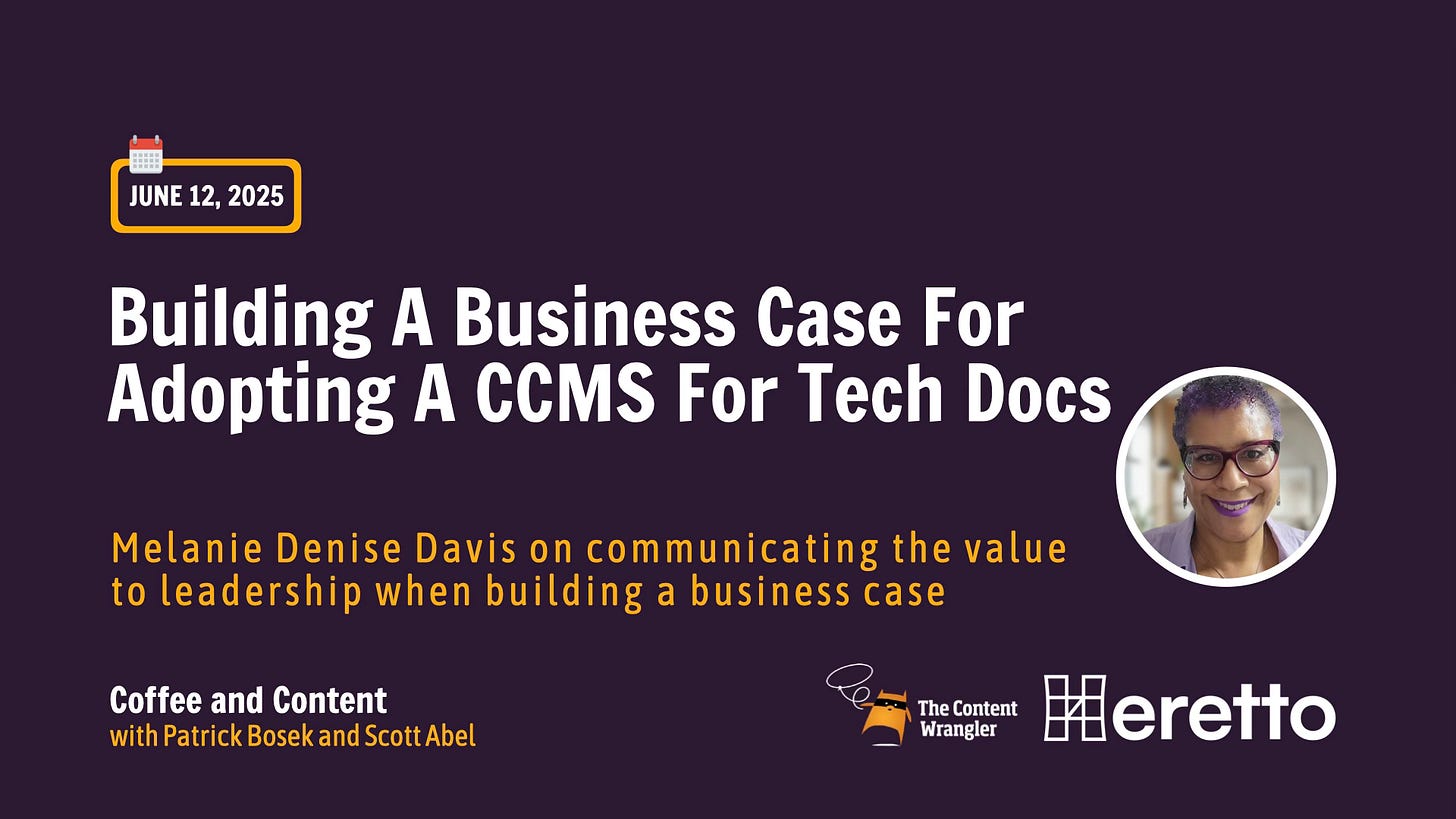
Building a Business Case for DITA and a CCMS for Technical Documentation
🗓️ June 12, 2025 — 8am PT
👉🏼 Register
Join us for a chat with Melanie Denise Davis, Founder and CEO of Dragonfly Diva Docs. Discover how your tech docs team can communicate the value of shifting from unstructured content creation to leveraging the power of semantically-rich structured content managed in a component content management system (CCMS).
The Content Wrangler is a reader-supported publication. To receive new posts and support my work, consider becoming a free or paid subscriber.
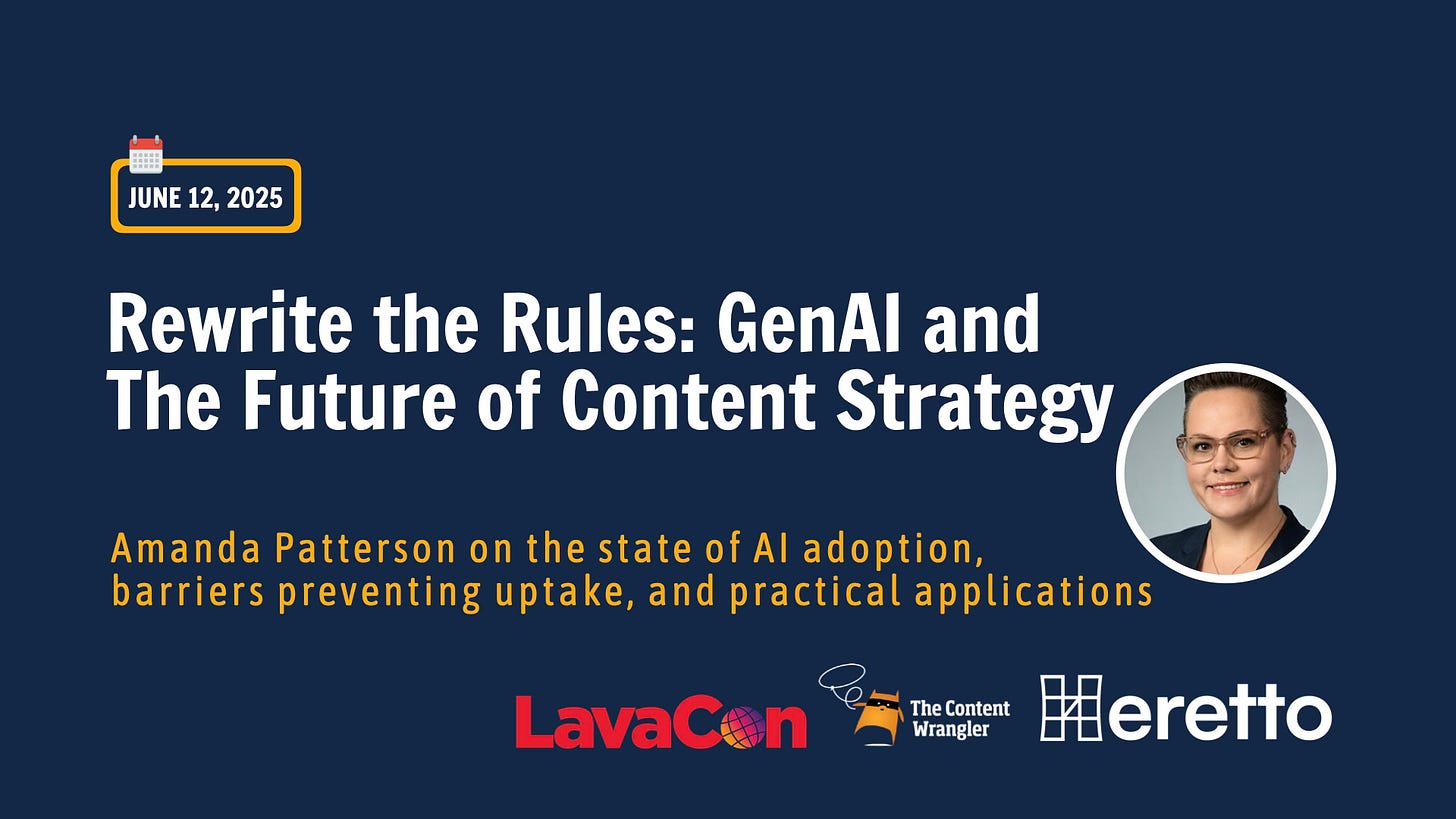
Rewrite the Rules: GenAI and The Future of Content Strategy
🗓️ June 12, 2025 — 10am PT
👉🏼 Register
Amanda Patterson cuts through the AI hype and gives you the real talk on making GenAI a seamless, strategic part of your content ecosystem. You’ll learn where AI fits, what risks you actually need to worry about, and how to convince leadership that this isn’t just another tech trend—it’s the future.

Graph-Driven Retrieval Augmented Generative AI Powered By DITA
🗓️ June 18, 2025 — 10am PT
👉🏼 Register
Can generative AI benefit from structured content? What role play knowledge graphs in this? And what does all of that have to do with DITA? After they discovered the shortcomings of vector-based RAG there is a buzz in the industry around knowledge graph-driven retrieval-augmented generation (Graph RAG). This session will examine whether and how DITA fits into that equation. Michael Iantosca, Senior Director of Content Platforms and Knowledge Engineering at Avalara will demonstrate a full-scale implementation of a graph-driven RAG based on intelligent structured content.
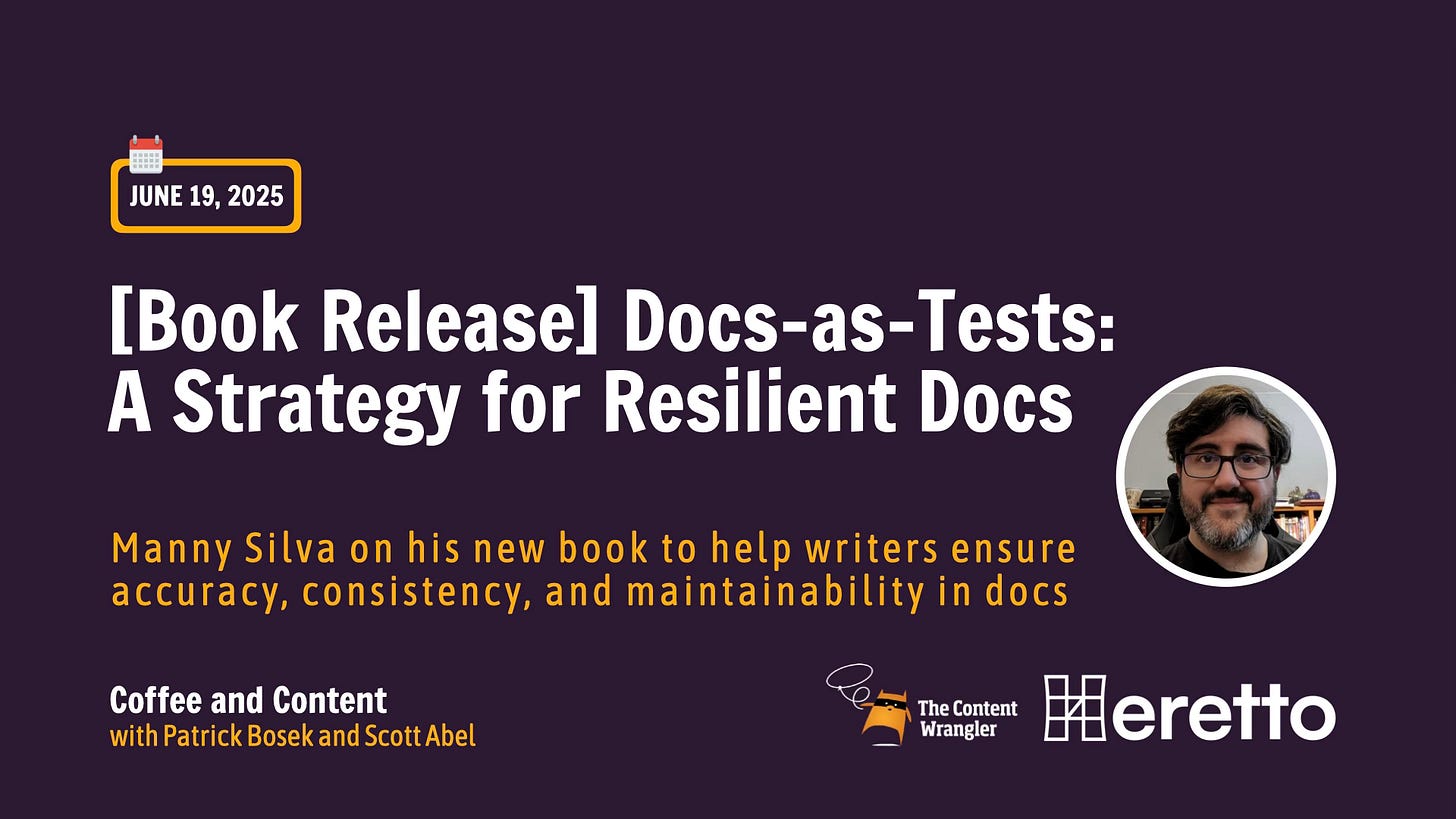
[Book Release] Docs-as-Tests: A Strategy for Resilient Docs
🗓️ June 19, 2025 — 8am PT
👉🏼 Register
Join us for a chat with Manny Silva, head of documentation at SkyFlow, and author of the newly released book, “Docs as Tests: A Strategy for Resilient Technical Documentation.” Manny will introduce us to the Docs-as-Tests approach—an innovative strategy that treats documentation as a first-class citizen in the software development lifecycle. Stick around for live Q&A—bring your questions and curiosity. One lucky viewer will win a free copy of Manny’s new book.

How GenAI Helps Developers Craft Better Internal Documentation
🗓️ June 25, 2025 — 8am PT
👉🏼 Register
Thiemo von Gillhaußen explores how a hybrid approach—combining generative AI, intelligent linguistic checking, and retrieval augmented generation (RAG)—can help contributors like software devs and engineers, write better content, faster.
Discover how Congree enables you to govern generative AI output using corporate style guides and terminology preferences—ensuring content quality without overwhelming contributors. Learn how using a local large language model (LLLM) to automatically align text with company standards while simplifying the writing and editing process for contributors.

The Power of Semantic Content Knowledge Graphs
🗓️ June 26, 2025 — 8am PT
👉🏼 Register
Join us for a chat with Arle Lommel, senior analyst at CSA Research and expert in language technology and semantic interoperability. Together, they’ll explore the growing importance of semantic content knowledge graphs and their role in improving content findability, automation, and personalization.
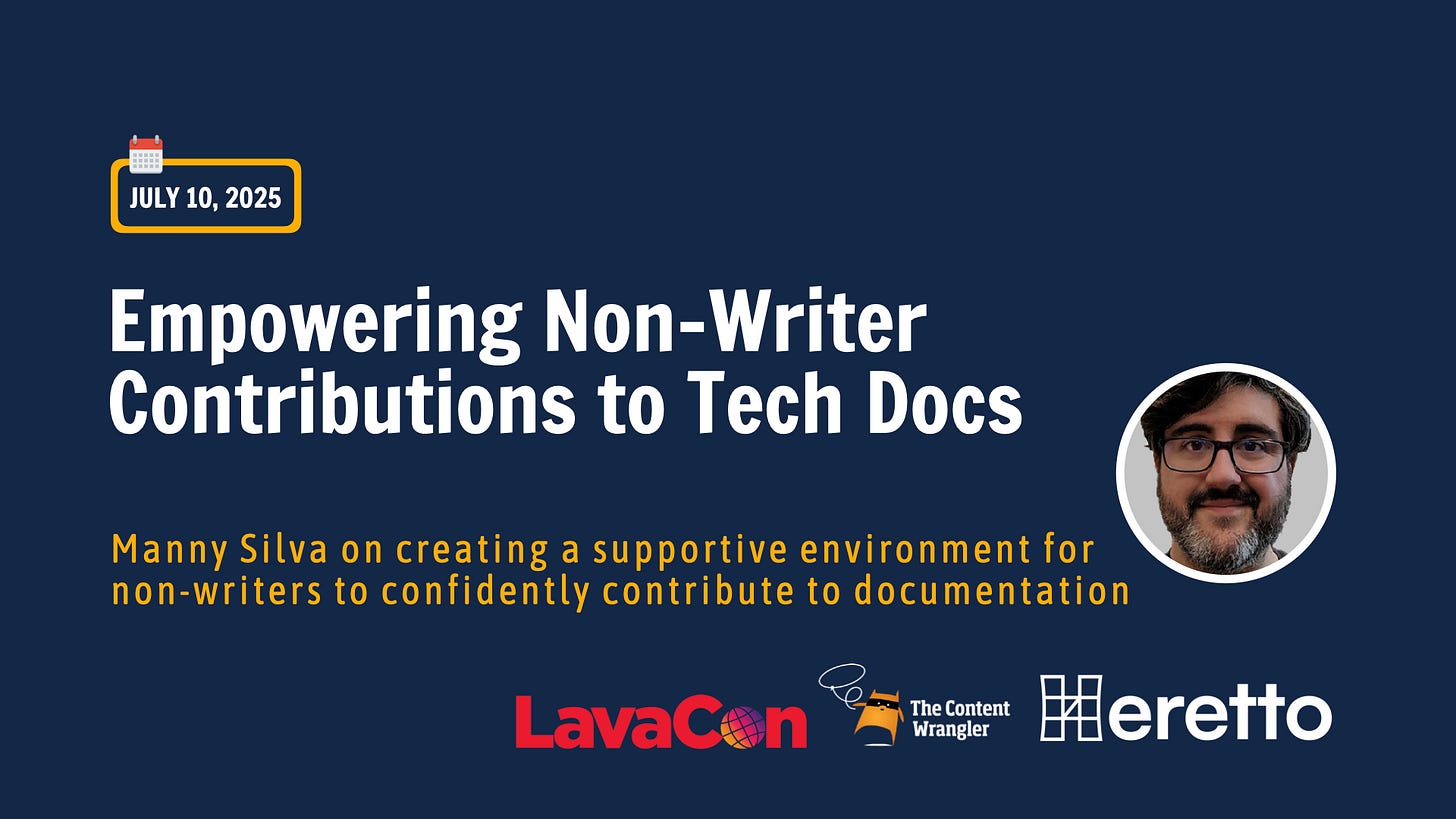
Lower the Barrier of Entry: Empowering Non-writer Contributions to Docs
🗓️ July 10, 2025 — 10am PT
👉🏼 Register
A presentation from Manny Silva, head of documentation at SkyFlow, during which he will demonstrate how modern tooling can create a supportive environment that empowers non-writers to confidently contribute to documentation.

The Sky Is Falling But Your Content Is Fine
🗓️ July 23, 2025 — 10am PT
👉🏼 Register
Jack Molisani explores how structured content will future-proof your content operations no matter what tech trends come along. Learn how to prepare content once and publish everywhere, from toasters to chatbots to jumbotrons and beyond.

What's Wrong With AI-Generated Technical Documentation?
🗓️ July 24, 2025 — 8am PT
👉🏼 Register
Tom Johnson, creator of I’d Rather Be Writing, and Fabrizio Ferri-Benedetti, technical communication expert — will unpack the challenges and pitfalls of relying on AI-generated docs. Drawing inspiration from the thought-provoking piece written by Ferri-Benedetti entitled, What’s Wrong with AI-Generated Docs?, they’ll discuss the shortcomings, practical issues, and unexpected consequences of letting AI take the wheel in tech comm. Expect an honest discussion about accuracy, consistency, and whether generative AI is truly ready to replace human writers.
The Content Wrangler is a reader-supported publication. To receive new posts and support my work, consider becoming a free or paid subscriber.





